
Preliminary W78LE516
8-BIT MICROCONTROLLER
Publication Release Date: June 2000
- 1 - Revision A1
GENERAL DESCRIPTION
The W78LE516 is an 8-bit microcontroller which has an in-system programmable MTP-ROM for
firmware updating. The instruction set of the W78LE516 is fully compatible with the standard 8052.
The W78LE516 contains a 64K bytes of main MTP-ROM and a 4K bytes of auxiliary MTP-ROM
which allows the contents of the 64KB main MTP-ROM to be updated by the loader program located
at the 4KB auxiliary MTP-ROM; 512 bytes of on-chip RAM; four 8-bit bi-directional and bit-
addressable I/O ports; an additional 4-bit port P4; three 16-bit timer/counters; a serial port. These
peripherals are supported by a eight sources two-level interrupt capability. To facilitate programming
and verification, the MTP-ROM inside the W78LE516 allows the program memory to be programmed
and read electronically. Once the code is confirmed, the user can protect the code for security.
The W78LE516 microcontroller has two power reduction modes, idle mode and power-down mode,
both of which are software selectable. The idle mode turns off the processor clock but allows for
continued peripheral operation. The power-down mode stops the crystal oscillator for minimum power
consumption. The external clock can be stopped at any time and in any state without affecting the
processor.
FEATURES
∑
Fully static design 8-bit CMOS microcontroller
∑
64K bytes of in-system programmable MTP-ROM for Application Program (APROM)
∑
4K bytes of auxiliary MTP-ROM for Loader Program (LDROM)
∑
512 bytes of on-chip RAM. (including 256 bytes of AUX-RAM, software selectable)
∑
64K bytes program memory address space and 64K bytes data memory address space
∑
Four 8-bit bi-directional ports
∑
One 4-bit multipurpose programmable port
∑
Three 16-bit timer/counters
∑
One full duplex serial port
∑
Eight-sources, two-level interrupt capability
∑
Built-in power management
∑
Code protection
∑
Packaged in
-
DIP 40: W78LE516-24
-
PLCC 44: W78LE516P-24
-
QFP 44: W78LE516F-24
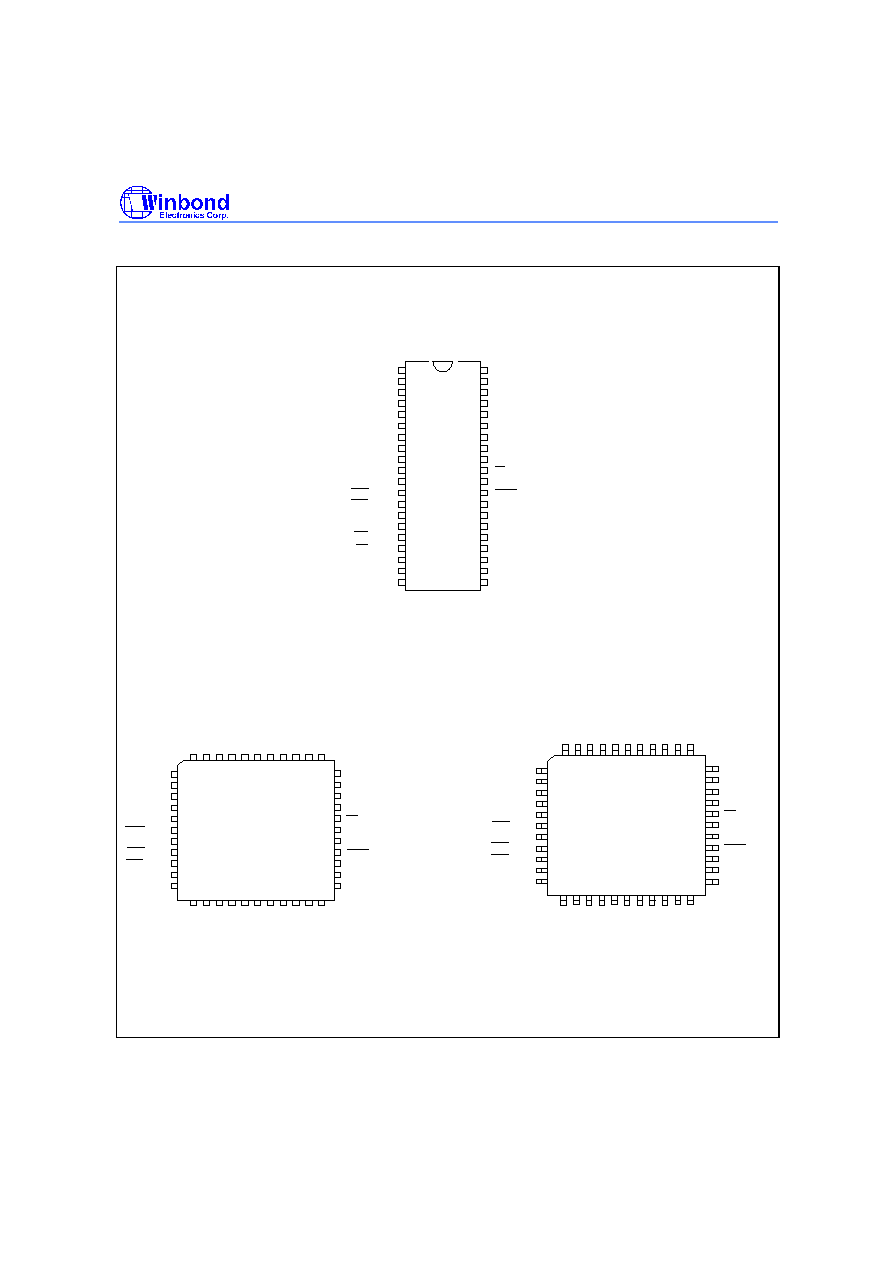
Preliminary W78LE516
- 2 -
PIN CONFIGURATIONS
VDD
1
2
3
4
5
6
7
8
9
10
11
12
13
14
15
16
17
18
19
20
39
40
34
35
36
37
38
30
31
32
33
26
27
28
29
21
22
23
24
25
P0.0, AD0
P0.1, AD1
P0.2, AD2
P0.3, AD3
P0.4, AD4
P0.5, AD5
P0.6, AD6
P0.7, AD7
EA
ALE
PSEN
P2.5, A13
P2.6, A14
P2.7, A15
P2.0, A8
P2.1, A9
P2.2, A10
P2.3, A11
P2.4, A12
T2, P1.0
40-Pin DIP (W78LE516)
P1.2
P1.3
P1.4
P1.5
P1.6
RXD, P3.0
TXD, P3.1
P1.7
RST
INT0, P3.2
INT1, P3.3
T0, P3.4
T1, P3.5
WR, P3.6
RD, P3.7
XTAL1
XTAL2
VSS
T2EX, P1.1
44-Pin PLCC (W78LE516P)
44-Pin QFP (W78LE516F)
40
2
1 44 43 42 41
6
5
4
3
39
38
37
36
35
34
33
32
31
30
29
28
27
26
25
24
23
22
21
20
19
18
17
10
9
8
7
14
13
12
11
16
15
P1.5
P1.6
P1.7
RST
RXD, P3.0
TXD, P3.1
INT0, P3.2
INT1, P3.3
T0, P3.4
T1, P3.5
A
D
3
,
P
0
.
3
T
2
,
P
1
.
0
P
1
.
2
V
D
D
A
D
2
,
P
0
.
2
A
D
1
,
P
0
.
1
A
D
0
,
P
0
.
0
T
2
E
X
,
P
1
.
1
P
1
.
3
P
1
.
4
X
T
A
L
1
V
S
S
P
2
.
4
,
A
1
2
P
2
.
3
,
A
1
1
P
2
.
2
,
A
1
0
P
2
.
1
,
A
9
P
2
.
0
,
A
8
X
T
A
L
2
P
3
.
7
,
/
R
D
P
3
.
6
,
/
W
R
P0.4, AD4
P0.5, AD5
P0.6, AD6
P0.7, AD7
EA
ALE
PSEN
P2.7, A15
P2.6, A14
P2.5, A13
P4.1
P
4
.
0
INT2, P4.3
/
I
N
T
3
,
P
4
.
2
34
40 39 38 37 36 35
44 43 42 41
33
32
31
30
29
28
27
26
25
24
23
P0.4, AD4
P0.5, AD5
P0.6, AD6
P0.7, AD7
EA
ALE
PSEN
P2.7, A15
P2.6, A14
P2.5, A13
22
21
20
19
18
17
16
15
14
13
12
11
4
3
2
1
8
7
6
5
10
9
P1.5
P1.6
P1.7
RST
RXD, P3.0
TXD, P3.1
INT0, P3.2
INT1, P3.3
T0, P3.4
T1, P3.5
X
T
A
L
1
V
S
S
P
2
.
4
,
A
1
2
P
2
.
3
,
A
1
1
P
2
.
2
,
A
1
0
P
2
.
1
,
A
9
P
2
.
0
,
A
8
X
T
A
L
2
P
3
.
7
,
/
R
D
P
3
.
6
,
/
W
R
A
D
3
,
P
0
.
3
T
2
,
P
1
.
0
P
1
.
2
V
D
D
A
D
2
,
P
0
.
2
A
D
1
,
P
0
.
1
A
D
0
,
P
0
.
0
T
2
E
X
,
P
1
.
1
P
1
.
3
P
1
.
4
P
4
.
0
/
I
N
T
3
,
P
4
.
2
P4.1
INT2, P4.3

Preliminary W78LE516
Publication Release Date: June 2000
- 3 - Revision A1
PIN DESCRIPTION
SYMBOL TYPE
DESCRIPTIONS
EA
I
EXTERNAL ACCESS ENABLE: This pin forces the processor to execute the
external ROM. The ROM address and data will not be presented on the bus if
the EA pin is high.
PSEN
O H PROGRAM STORE ENABLE: PSEN enables the external ROM data in the
Port 0 address/data bus. When internal ROM access is performed, no PSEN
strobe signal outputs originate from this pin.
ALE
O H ADDRESS LATCH ENABLE: ALE is used to enable the address latch that
separates the address from the data on Port 0. ALE runs at 1/6th of the
oscillator frequency.
RST
I L RESET: A high on this pin for two machine cycles while the oscillator is
running resets the device.
XTAL1
I
CRYSTAL 1: This is the crystal oscillator input. This pin may be driven by an
external clock.
XTAL2
O
CRYSTAL 2: This is the crystal oscillator output. It is the inversion of XTAL1.
V
SS
I
GROUND: ground potential.
V
DD
I
POWER SUPPLY: Supply voltage for operation.
P0.0
-
P0.7
I/O D PORT 0: Function is the same as that of standard 8052.
P1.0
-
P1.7
I/O H PORT 1: Function is the same as that of standard 8052.
P2.0
-
P2.7
I/O H PORT 2: Port 2 is a bi-directional I/O port with internal pull-ups. This port also
provides the upper address bits for accesses to external memory.
P3.0
-
P3.7
I/O H PORT 3: Function is the same as that of the standard 8052.
P4.0
-
P4.3
I/O H PORT 4: A bi-directional I/O. See details below.
* Note:
TYPE I: input, O: output, I/O: bi-directional, H: pull-high, L: pull-low, D: open drain
PORT4
Another bit-addressable port P4 is also available and only 4 bits (P4<3:0>) can be used. This port
address is located at 0D8H with the same function as that of port P1,
Example:
P4 REG 0D8H
MOV P4, #0AH ; Output data "A" through P4.0
-
P4.3.
MOV A, P4 ; Read P4 status to Accumulator.
SETB P4.0 ; Set bit P4.0
CLR P4.1 ; Clear bit P4.1
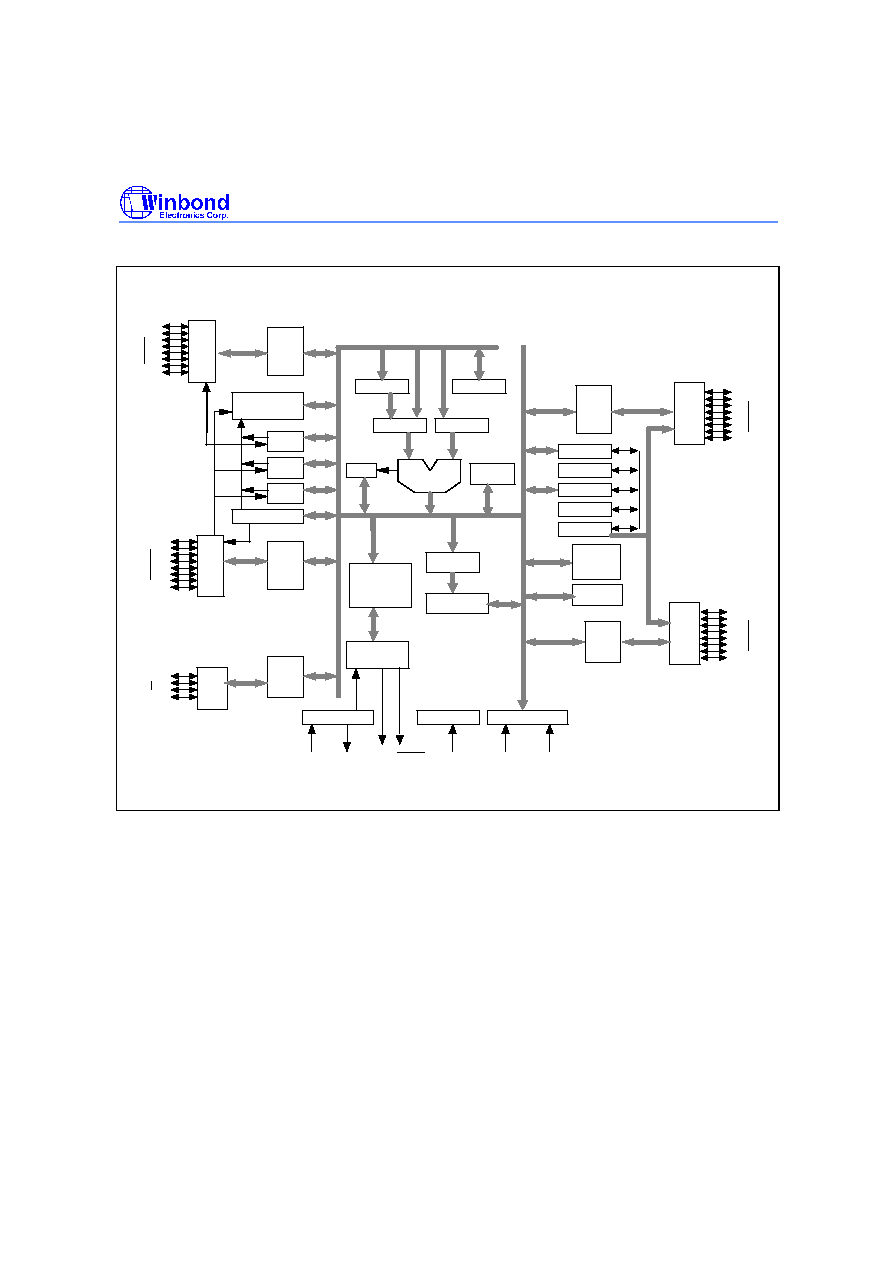
Preliminary W78LE516
- 4 -
BLOCK DIAGRAM
P3.0
P3.7
P1.0
P1.7
ALU
Port 0
Latch
Port 1
Latch
Timer
1
Timer
0
Timer
2
Port
1
UART
XTAL1
PSEN
ALE
Vss
VCC
RST
XTAL2
Oscillator
Interrupt
PSW
Instruction
Decoder
&
Sequencer
Reset Block
Bus & Clock
Controller
SFR RAM
Address
Power control
512 bytes
RAM & SFR
Stack
Pointer
B
Addr. Reg.
Incrementor
PC
DPTR
Temp Reg.
T2
T1
ACC
Port 3
Latch
Port 4
Latch
Port
3
Port 2
Latch
P4.0
P4.3
Port
4
Port
0
Port
2
P2.0
P2.7
P0.0
P0.7
64KB
MTP-ROM
4KB
MTP-ROM
FUNCTIONAL DESCRIPTION
The W78LE516 architecture consists of a core controller surrounded by various registers, four general
purpose I/O ports, one special purpose programmable 4-bits I/O port, 512 bytes of RAM, three
timer/counters, a serial port. The processor supports 111 different opcodes and references both a 64K
program address space and a 64K data storage space.
RAM
The internal data RAM in the W78LE516 is 512 bytes. It is divided into two banks: 256 bytes of
scratchpad RAM and 256 bytes of AUX-RAM. These RAMs are addressed by different ways.
∑
RAM 0H
-
7FH can be addressed directly and indirectly as the same as in 8051. Address pointers
are R0 and R1 of the selected register bank.

Preliminary W78LE516
Publication Release Date: June 2000
- 5 - Revision A1
∑
RAM 80H
-
FFH can only be addressed indirectly as the same as in 8051. Address pointers are R0,
R1 of the selected registers bank.
∑
AUX-RAM 0H
-
FFH is addressed indirectly as the same way to access external data memory with
the MOVX instruction. Address pointer are R0 and R1 of the selected register bank and DPTR
register. An access to external data memory locations higher than FFH will be performed with the
MOVX instruction in the same way as in the 8051. The AUX-RAM is disable after a reset. Setting
the bit 4 in CHPCON register will enable the access to AUX-RAM. When AUX-RAM is enabled the
instructions of "MOVX @Ri" will always access to on-chip AUX-RAM. When executing from internal
program memory, an access to AUX-RAM will not affect the Ports P0, P2, WR and RD .
Example,
CHPENR REG F6H
CHPCON REG BFH
MOV CHPENR,#87H
MOV CHPENR,#59H
ORL CHPCON,#00010000B ; enable AUX-RAM
MOV CHPENR,#00H
MOV R0,#12H
MOV A,#34H
MOVX @R0,A ; Write 34h data to 12h address.
Timers 0, 1, and 2
Timers 0, 1, and 2 each consist of two 8-bit data registers. These are called TL0 and TH0 for Timer
0, TL1 and TH1 for Timer 1, and TL2 and TH2 for Timer 2. The TCON and TMOD registers provide
control functions for timers 0, 1. The T2CON register provides control functions for Timer 2. RCAP2H
and RCAP2L are used as reload/capture registers for Timer 2. The operations of Timer 0 and Timer
1 are the same as in the W78C51. Timer 2 is a 16-bit timer/counter that is configured and controlled
by the T2CON register. Like Timers 0 and 1, Timer 2 can operate as either an external event counter
or as an internal timer, depending on the setting of bit C/T2 in T2CON. Timer 2 has three operating
modes: capture, auto-reload, and baud rate generator. The clock speed at capture or auto-reload
mode is the same as that of Timers 0 and 1.
Clock
The W78LE516 is designed with either a crystal oscillator or an external clock. Internally, the clock is
divided by two before it is used by default. This makes the W78LE516 relatively insensitive to duty
cycle variations in the clock.
Crystal Oscillator
The W78LE516 incorporates a built-in crystal oscillator. To make the oscillator work, a crystal must
be connected across pins XTAL1 and XTAL2. In addition, a load capacitor must be connected from
each pin to ground.
External Clock
An external clock should be connected to pin XTAL1. Pin XTAL2 should be left unconnected. The
XTAL1 input is a CMOS-type input, as required by the crystal oscillator.

Preliminary W78LE516
- 6 -
Power Management
Idle Mode
Setting the IDL bit in the PCON register enters the idle mode. In the idle mode, the internal clock to
the processor is stopped. The peripherals and the interrupt logic continue to be clocked. The
processor will exit idle mode when either an interrupt or a reset occurs.
Power-down Mode
When the PD bit in the PCON register is set, the processor enters the power-down mode. In this
mode all of the clocks are stopped, including the oscillator. To exit from power-down mode is by a
hardware reset or external interrupts INT0 to INT1 when enabled and set to level triggered.
Reduce EMI Emission
The W78LE516 allows user to diminish the gain of on-chip oscillator amplifier by using programmer
to clear the B7 bit of security register. Once B7 is set to 0, a half of gain will be decreased. Care must
be taken if user attempts to diminish the gain of oscillator amplifier, reducing a half of gain may affect
the external crystal operating improperly at high frequency. The value of C1 ana C2 may need some
adjustment while running at lower gain.
Reset
The external RESET signal is sampled at S5P2. To take effect, it must be held high for at least two
machine cycles while the oscillator is running. An internal trigger circuit in the reset line is used to
deglitch the reset line when the W78LE516 is used with an external RC network. The reset logic also
has a special glitch removal circuit that ignores glitches on the reset line. During reset, the ports are
initialized to FFH, the stack pointer to 07H, PCON (with the exception of bit 4) to 00H, and all of the
other SFR registers except SBUF to 00H. SBUF is not reset.
W78LE516 Special Function Registers (SFRs) and Reset Values
F8
FF
F0
+B
00000000
CHPENR
00000000
F7
E8
EF
E0
+ACC
00000000
E7
D8
+P4
xxxx1111
DF
D0
+PSW
00000000
D7
C8
+T2CON
00000000
RCAP2L
00000000
RCAP2H
00000000
TL2
00000000
TH2
00000000
CF
C0
XICON
00000000
P4CONA
00000000
P4CONB
00000000
SFRAL
00000000
SFRAH
00000000
SFRFD
00000000
SFRCN
00000000
C7
B8
+IP
00000000
CHPCON
0xx00000
BF
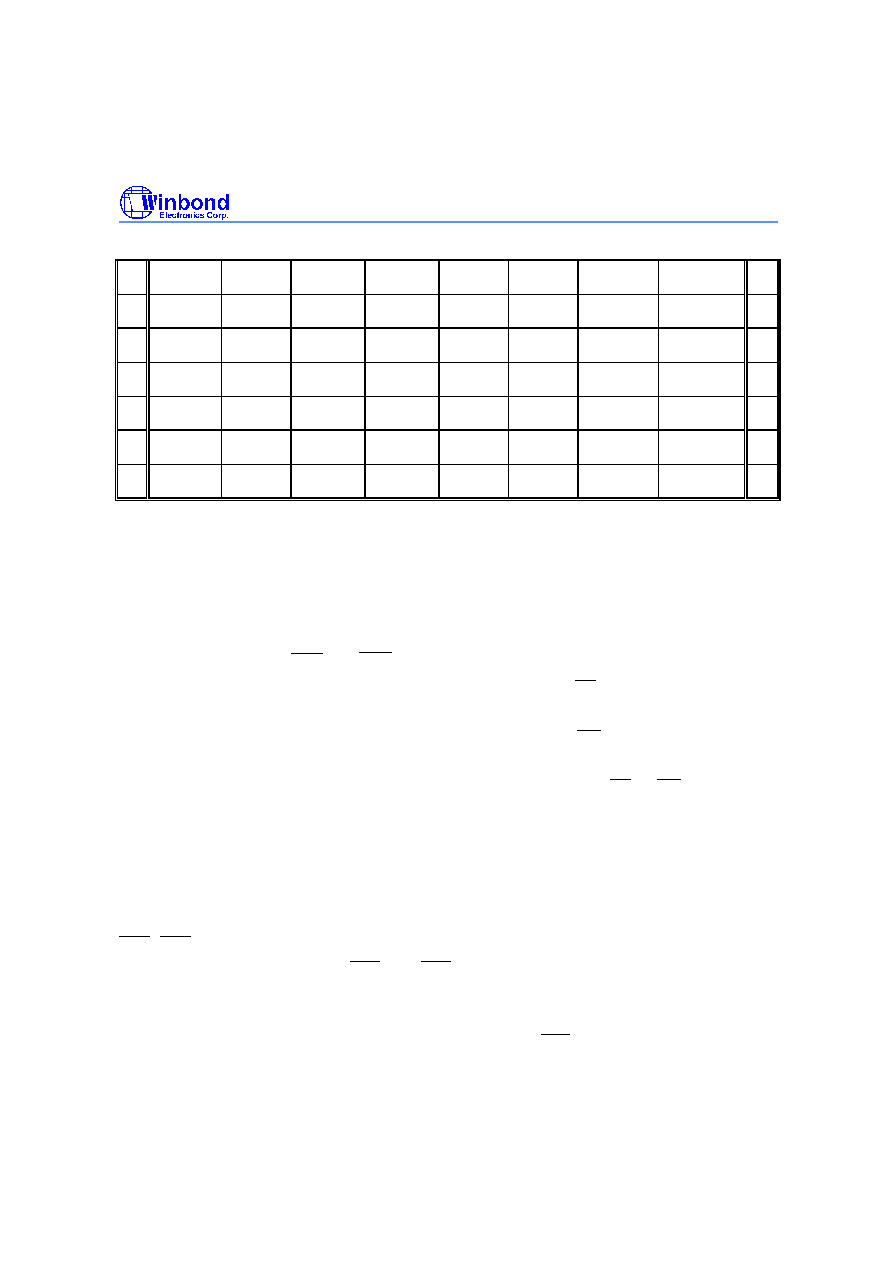
Preliminary W78LE516
Publication Release Date: June 2000
- 7 - Revision A1
Continued
B0
+P3
00000000
P43AL
00000000
P43AH
00000000
B7
A8
+IE
00000000
P42AL
00000000
P42AH
00000000
P2ECON
0000xx00
AF
A0
+P2
11111111
A7
98
+SCON
00000000
SBUF
xxxxxxxx
9F
90
+P1
11111111
P41AL
00000000
P41AH
00000000
97
88
+TCON
00000000
TMOD
00000000
TL0
00000000
TL1
00000000
TH0
00000000
TH1
00000000
8F
80
+P0
11111111
SP
00000111
DPL
00000000
DPH
00000000
P40AL
00000000
P40AH
00000000
PCON
00110000
87
Notes:
1.The SFRs marked with a plus sign(+) are both byte- and bit-addressable.
2. The text of SFR with bold type characters are extension function registers.
Port 4
Port 4, address D8H, is a 4-bit multipurpose programmable I/O port. Each bit can be configured
individually by software. The Port 4 has four different operation modes.
Mode 0: P4.0
-
P4.3 is a bi-directional I/O port which is same as port 1. P4.2 and P4.3 also serve as
external interrupt
CLR
and
INT2
if enabled.
Mode 1: P4.0
-
P4.3 are read strobe signals that are synchronized with RD signal at specified
addresses. These signals can be used as chip-select signals for external peripherals.
Mode 2: P4.0
-
P4.3 are write strobe signals that are synchronized with WR signal at specified
addresses. These signals can be used as chip-select signals for external peripherals.
Mode 3: P4.0
-
P4.3 are read/write strobe signals that are synchronized with RD or WR signal at
specified addresses. These signals can be used as chip-select signals for external
peripherals.
When Port 4 is configured with the feature of chip-select signals, the chip-select signal address range
depends on the contents of the SFR P4xAH, P4xAL, P4CONA and P4CONB. The registers P4xAH
and P4xAL contain the 16-bit base address of P4.x. The registers P4CONA and P4CONB contain the
control bits to configure the Port 4 operation mode.
INT2 / INT3
Two additional external interrupts, INT2 and INT3 , whose functions are similar to those of external
interrupt 0 and 1 in the standard 80C52. The functions/status of these interrupts are
determined/shown by the bits in the XICON (External Interrupt Control) register. The XICON register
is bit-addressable but is not a standard register in the standard 80C52. Its address is at 0C0H. To
set/clear bits in the XICON register, one can use the "SETB ( CLR ) bit" instruction. For example,
"SETB 0C2H" sets the EX2 bit of XICON.
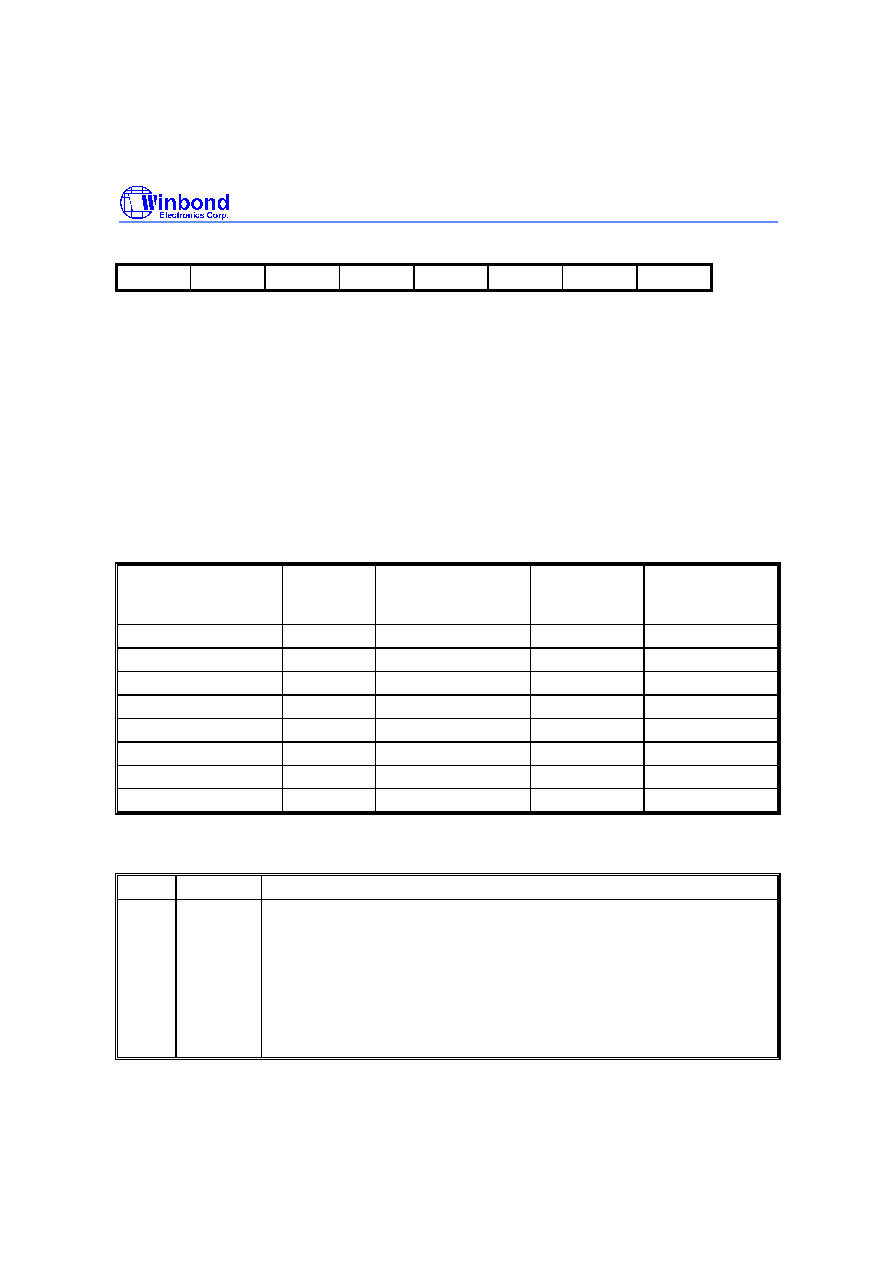
Preliminary W78LE516
- 8 -
XICON - external interrupt control (C0H)
PX3
EX3
IE3
IT3
PX2
EX2
IE2
IT2
PX3:External interrupt 3 priority high if set
EX3:External interrupt 3 enable if set
IE3:If IT3 = 1, IE3 is set/cleared automatically by hardware when interrupt is detected/serviced
IT3:External interrupt 3 is falling-edge/low-level triggered when this bit is set/cleared by software
PX2:External interrupt 2 priority high if set
EX2:External interrupt 2 enable if set
IE2:If IT2 = 1, IE2 is set/cleared automatically by hardware when interrupt is detected/serviced
IT2:External interrupt 2 is falling-edge/low-level triggered when this bit is set/cleared by software
Eight-source interrupt information:
INTERRUPT
SOURCE
VECTOR
ADDRESS
POLLING
SEQUENCE WITHIN
PRIORITY LEVEL
ENABLE
REQUIRED
SETTINGS
INTERRUPT
TYPE
EDGE/LEVEL
External Interrupt 0
03H
0 (highest)
IE.0
TCON.0
Timer/Counter 0
0BH
1
IE.1
-
External Interrupt 1
13H
2
IE.2
TCON.2
Timer/Counter 1
1BH
3
IE.3
-
Serial Port
23H
4
IE.4
-
Timer/Counter 2
2BH
5
IE.5
-
External Interrupt 2
33H
6
XICON.2
XICON.0
External Interrupt 3
3BH
7 (lowest)
XICON.6
XICON.3
P4CONB (C3H)
BIT
NAME
FUNCTION
7, 6
P43FUN1
P43FUN0
00: Mode 0. P4.3 is a general purpose I/O port which is the same as Port1.
01: Mode 1. P4.3 is a Read Strobe signal for chip select purpose. The address
range depends on the SFR P43AH, P43AL, P43CMP1 and P43CMP0.
10: Mode 2. P4.3 is a Write Strobe signal for chip select purpose. The address
range depends on the SFR P43AH, P43AL, P43CMP1 and P43CMP0.
11: Mode 3. P4.3 is a Read/Write Strobe signal for chip select purpose. The
address range depends on the SFR P43AH, P43AL, P43CMP1, and
P43CMP0.

Preliminary W78LE516
Publication Release Date: June 2000
- 9 - Revision A1
P4CONB (C3H), continued
BIT
NAME
FUNCTION
5, 4
P43CMP1
P43CMP0
Chip-select signals address comparison:
00: Compare the full address (16 bits length) with the base address register
P43AH, P43AL.
01: Compare the 15 high bits (A15
-
A1) of address bus with the base address
register P43AH, P43AL.
10: Compare the 14 high bits (A15
-
A2) of address bus with the base address
register P43AH, P43AL.
11: Compare the 8 high bits (A15
-
A8) of address bus with the base address
register P43AH, P43AL.
3, 2
P42FUN1
P42FUN0
The P4.2 function control bits which are the similar definition as P43FUN1,
P43FUN0.
1, 0
P42CMP1
P42CMP0
The P4.2 address comparator length control bits which are the similar
definition as P43CMP1, P43CMP0.
P4CONA (C2H)
BIT
NAME
FUNCTION
7, 6
P41FUN1
P41FUN0
The P4.1 function control bits which are the similar definition as P43FUN1,
P43FUN0.
5, 4
P41CMP1
P41CMP0
The P4.1 address comparator length control bits which are the similar
definition as P43CMP1, P43CMP0.
3, 2
P40FUN1
P40FUN0
The P4.0 function control bits which are the similar definition as P43FUN1,
P43FUN0.
1, 0
P40CMP1
P40CMP0
The P4.0 address comparator length control bits which are the similar
definition as P43CMP1, P43CMP0.
P2ECON (AEH)
BIT
NAME
FUNCTION
7
P43CSINV The active polarity of P4.3 when pin P4.3 is defined as read and/or write
strobe signal.
= 1 : P4.3 is active high when pin P4.3 is defined as read and/or write strobe
signal.
= 0 : P4.3 is active low when pin P4.3 is defined as read and/or write strobe
signal.
6
P42CSINV The similarity definition as P43SINV.
5
P41CSINV The similarity definition as P43SINV.
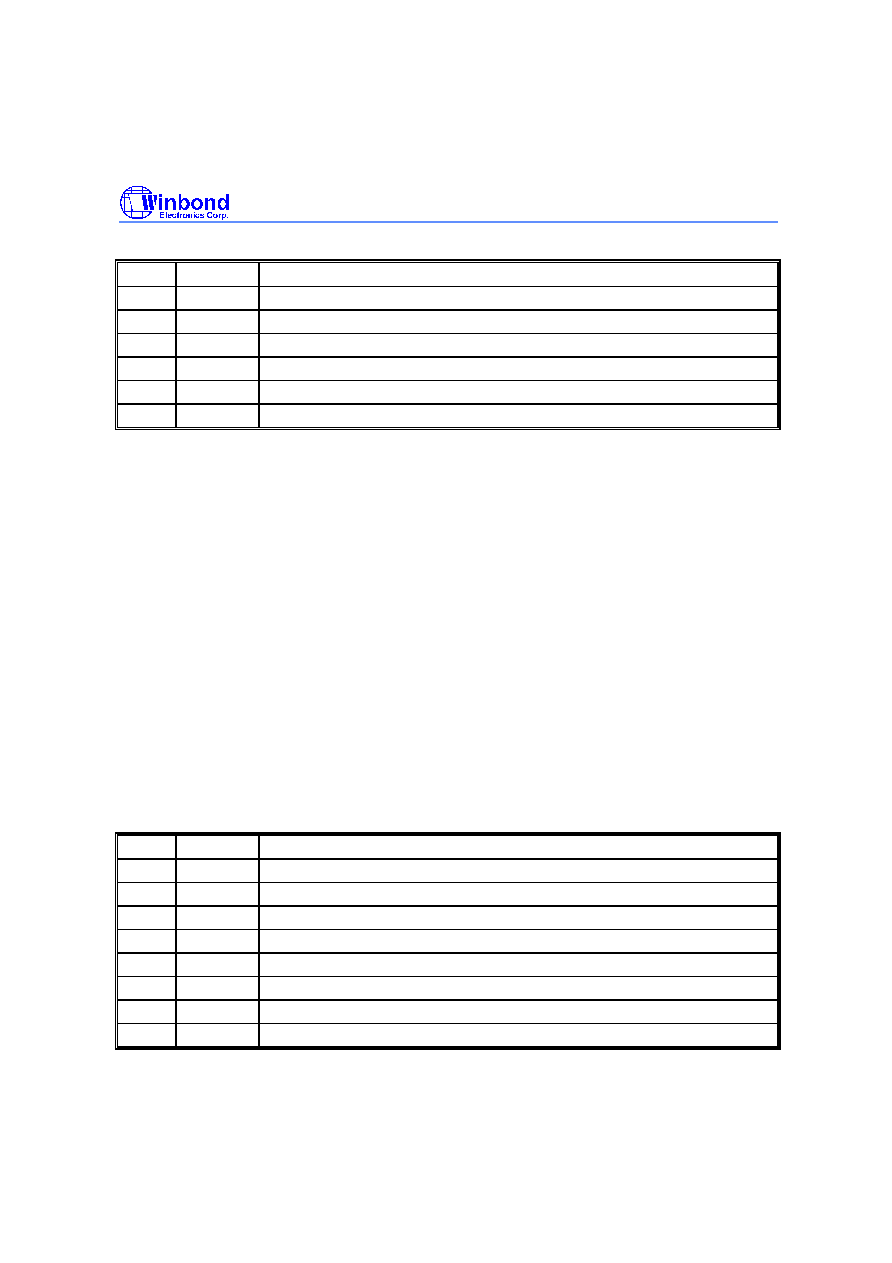
Preliminary W78LE516
- 10 -
P2ECON (AEH), continued
BIT
NAME
FUNCTION
5
P41CSINV The similarity definition as P43SINV.
4
P40CSINV The similarity definition as P43SINV.
3
-
Reserve
2
-
Reserve
1
-
0
0
-
0
Port 4 Base Address Registers
P40AH, P40AL:
The Base address register for comparator of P4.0. P40AH contains the high-order byte of address,
P40AL contains the low-order byte of address.
P41AH, P41AL:
The Base address register for comparator of P4.1. P41AH contains the high-order byte of address,
P41AL contains the low-order byte of address.
P42AH, P42AL:
The Base address register for comparator of P4.2. P42AH contains the high-order byte of address,
P42AL contains the low-order byte of address.
P43AH, P43AL:
The Base address register for comparator of P4.3. P43AH contains the high-order byte of address,
P43AL contains the low-order byte of address.
P4 (D8H)
BIT
NAME
FUNCTION
7
-
Reserve
6
-
Reserve
5
-
Reserve
4
-
Reserve
3
P43
Port 4 Data bit which outputs to pin P4.3 at mode 0.
2
P42
Port 4 Data bit. which outputs to pin P4.2 at mode 0.
1
P41
Port 4 Data bit. which outputs to pin P4.1at mode 0.
0
P40
Port 4 Data bit which outputs to pin P4.0 at mode 0.
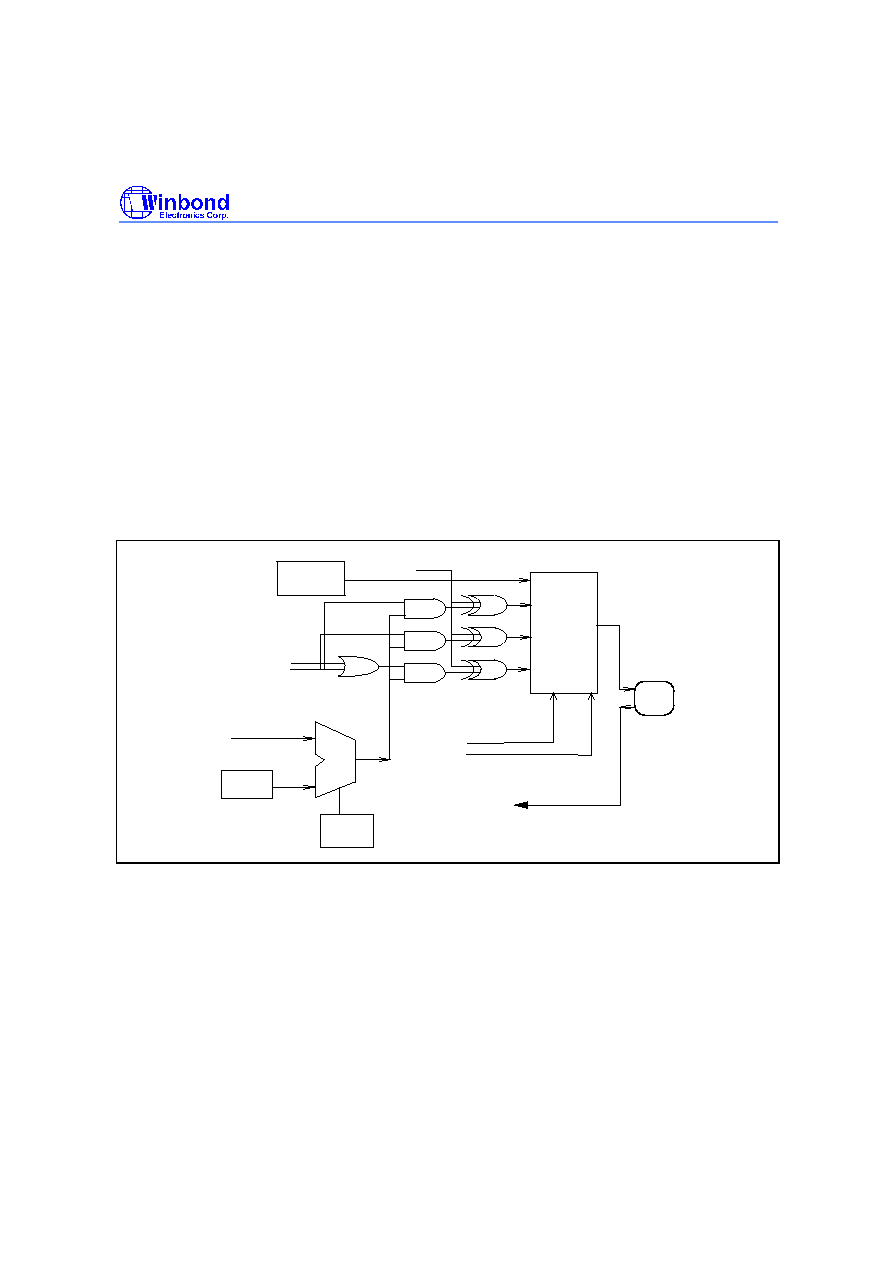
Preliminary W78LE516
Publication Release Date: June 2000
- 11 - Revision A1
Here is an example to program the P4.0 as a write strobe signal at the I/O port address
1234H
-
1237H and positive polarity, and P4.1
-
P4.3 are used as general I/O ports.
MOV P40AH,#12H
MOV P40AL,#34H ; Base I/O address 1234H for P4.0
MOV P4CONA,#00001010B ; P4.0 a write strobe signal and address line A0 and A1 are masked.
MOV P4CONB,#00H ; P4.1
-
P4.3 as general I/O port which are the same as PORT1
MOV P2ECON,#10H ; Write the P40SINV = 1 to inverse the P4.0 write strobe polarity
; default is negative.
MOV CHPENR,#00H ; Disable CHPCON write attribute.
Then any instruction MOVX @DPTR,A (with DPTR = 1234H
-
1237H) will generate the positive
polarity write strobe signal at pin P4.0. And the instruction MOV P4,#XX will output the bit3 to bit1 of
data #XX to pin P4.3
-
P4.1.
ADDRESS BUS
Bit Length
Selectable
comparator
REGISTER
P4xAL
P4xAH
EQUAL
P4.x
MUX 4->1
P4 REGISTER
P4.x
READ
WRITE
DATA I/O
RD_CS
WR_CS
RD/WR_CS
P4xCMP0
P4xCMP1
P4xFUN0
P4xFUN1
P4xCSINV
P4.x INPUT DATA BUS
REGISTER
PIN
In-System Programming (ISP) Mode
The W78LE516 equips one 64K byte of main MTP-ROM bank for application program (called
APROM) and one 4K byte of auxiliary MTP-ROM bank for loader program (called LDROM). In the
normal operation, the microcontroller executes the code in the APROM. If the content of APROM
needs to be modified, the W78LE516 allows user to activate the In-System Programming (ISP) mode
by setting the CHPCON register. The CHPCON is read-only by default, software must write two
specific values 87H, then 59H sequentially to the CHPENR register to enable the CHPCON
write attribute. Writing CHPENR register with the values except 87H and 59H will close
CHPCON register write attribute. The W78LE516 achieves all in-system programming operations
including enter/exit ISP Mode, program, erase, read ... etc, during device in the idle mode. Setting the

Preliminary W78LE516
- 12 -
bit CHPCON.0 the device will enter in-system programming mode after a wake-up from idle mode.
Because device needs proper time to complete the ISP operations before awaken from idle mode,
software may use timer interrupt to control the duration for device wake-up from idle mode. To
perform ISP operation for revising contents of APROM, software located at APROM setting the
CHPCON register then enter idle mode, after awaken from idle mode the device executes the
corresponding interrupt service routine in LDROM. Because the device will clear the program counter
while switching from APROM to LDROM, the first execution of RETI instruction in interrupt service
routine will jump to 00H at LDROM area. The device offers a software reset for switching back to
APROM while the content of APROM has been updated completely. Setting CHPCON register bit 0,
1 and 7 to logic-1 will result a software reset to reset the CPU. The software reset serves as a
external reset. This in-system programming feature makes the job easy and efficient in which the
application needs to update firmware frequently. In some applications, the in-system programming
feature make it possible to easily update the system firmware without opening the chassis.
Note: The ISP Mode operates by supply voltage from 3.3V to 5.5V.
SFRAH, SFRAL:
The objective address of on-chip MTP-ROM in the in-system programming mode.
SFRAH contains the high-order byte of address, SFRAL contains the low-order
byte of address.
SFRFD:
The programming data for on-chip MTP-ROM in programming mode.
SFRCN:
The control byte of on-chip MTP-ROM programming mode.
SFRCN (C7)
BIT
NAME
FUNCTION
7
-
Reserve.
6
WFWIN On-chip MTP-ROM bank select for in-system programming.
= 0: 64K bytes MTP-ROM bank is selected as destination for re-
programming.
= 1: 4K bytes MTP-ROM bank is selected as destination for re-programming.
5
OEN
MTP-ROM output enable.
4
CEN
MTP-ROM chip enable.
3, 2, 1, 0 CTRL[3:0] The flash control signals
MODE
WFWIN CTRL<3:0> OEN CEN SFRAH, SFRAL SFRFD
Erase 64KB APROM
0
0010
1
0
X
X
Program 64KB APROM
0
0001
1
0
Address in
Data in
Read 64KB APROM
0
0000
0
0
Address in
Data out
Erase 4KB LDROM
1
0010
1
0
X
X
Program 4KB LDROM
1
0001
1
0
Address in
Data in
Read 4KB LDROM
1
0000
0
0
Address in
Data out

Preliminary W78LE516
Publication Release Date: June 2000
- 13 - Revision A1
In-System Programming Control Register (CHPCON)
CHPCON (BFH)
BIT
NAME
FUNCTION
7
SWRESET
(F04KMODE)
When this bit is set to 1, and both FBOOTSL and FPROGEN are set to 1. It
will enforce microcontroller reset to initial condition just like power on reset.
This action will re-boot the microcontroller and start to normal operation. To
read this bit in logic-1 can determine that the F04KBOOT mode is running.
6
-
Reserve.
5
-
Reserve.
4
ENAUXRAM
1: Enable on-chip AUX-RAM.
0: Disable the on-chip AUX-RAM
3
0
Must set to 0.
2
0
Must set to 0.
1
FBOOTSL The Program Location Select.
0: The Loader Program locates at the 64 KB APROM. 4KB LDROM is
destination for re-programming.
1: The Loader Program locates at the 4 KB memory bank. 64KB APROM is
destination for re-programming.
0
FPROGEN MTP-ROM Programming Enable.
= 1: enable. The microcontroller enter the in-system programming mode after
entering the idle mode and wake-up from interrupt. During in-system
programming mode, the operation of erase, program and read are
achieve when device enters idle mode.
= 0: disable. The on-chip flash memory is read-only. In-system
programmability is disabled.

Preliminary W78LE516
- 14 -
F04KBOOT Mode (Boot From LDROM)
By default, the W78LE516 boots from APROM program after a power on reset. On some occasions,
user can force the W78LE516 to boot from the LDROM program via following settings
.
The possible
situation that you need to enter F04KBOOT mode when the APROM program can not run properly
and device can not jump back to LDROM to execute in-system programming function. Then you can
use this F04KBOOT mode to force the W78LE516 jumps to LDROM and executes in-system
programming procedure. When you design your system, you may reserve the pins P2.6, P2.7 to
switches or jumpers. For example in a CD-ROM system, you can connect the P2.6 and P2.7 to PLAY
and EJECT buttons on the panel. When the APROM program fails to execute the normal application
program. User can press both two buttons at the same time and then turn on the power of the
personal computer to force the W78LE516 to enter the F04KBOOT mode. After power on of personal
computer, you can release both buttons and finish the in-system programming procedure to update
the APROM code.
In application system design, user must take care of the P2, P3, ALE, EA and
PSEN pin value at reset to prevent from accidentally activating the programming mode or
F04KBOOT mode.
F04KBOOT MODE
P4.3 P2.7 P2.6
MODE
X
L
L
FO4KBOOT
L
X
X
FO4KBOOT
P2.7
P2.6
RST
30 mS
Hi-Z
The Reset Timing For Entering
F04KBOOT Mode
10 mS
Hi-Z
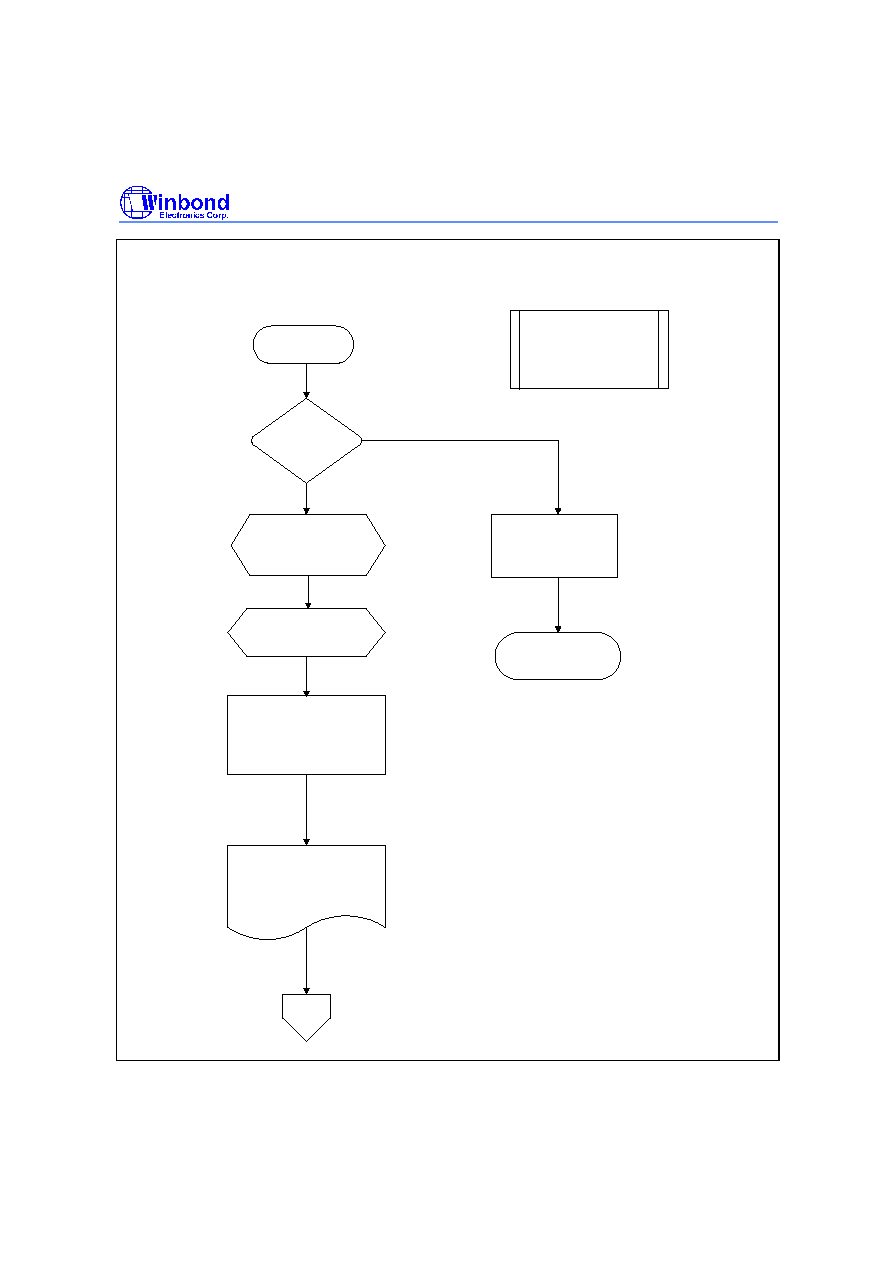
Preliminary W78LE516
Publication Release Date: June 2000
- 15 - Revision A1
START
The Algorithm of In-System Programming
Enter In-System
Programming Mode ?
(conditions depend on
user's application)
Setting control registers
MOV CHPENR,#87H
MOV CHPENR,#59H
MOV CHPCON,#03H
Setting Timer (about 1.5 us)
and enable timer interrupt
Start Timer and enter idle Mode.
(CPU will be wakened from idle mode
by timer interrupt, then enter In-System
Programming mode)
Execute the normal application
program
No
Yes
END
CPU will be wakened by interrupt and
re-boot from 4KB LDROM to execute
the loader program.
Go
Part 1:64KB APROM
procedure of entering
In-System Programming Mode

Preliminary W78LE516
- 16 -
Part 2: 4KB LDROM
Procedure of Updating
the 64KB APROM
Go
Timer Interrupt Service Routine:
Stop Timer & disable interrupt
Is F04KBOOT Mode?
(CHPCON.7=1)
Reset the CHPCON Register:
MOV CHPENR,#87H
MOV CHPENR,#59H
MOV CHPCON,#03H
No
Yes
Setting Timer and enable Timer
interrupt for wake-up .
(15 ms for erasing operation)
Setting erase operation mode:
MOV SFRCN,#22H
(Erase 64KB APROM)
Start Timer and enter IDLE
Mode.
(Erasing...)
End of erase
operation. CPU will
be wakened by Timer
interrupt.
PGM
PGM
Setting Timer and enable Timer
interrupt for wake-up .
(50us for program operation)
End of Programming ?
Get the parameters of new code
(Address and data bytes)
through I/O ports, UART or
other interfaces.
Is currently in the
F04KBOOT Mode ?
Setting control registers for
programming:
MOV SFRAH,#ADDRESS_H
MOV SFRAL,#ADDRESS_L
MOV SFRFD,#DATA
MOV SFRCN,#21H
Software reset CPU and
re-boot from the 64KB
APROM.
MOV CHPENR,#87H
MOV CHPENR,#59H
MOV CHPCON,#83H
END
Executing new code
from address
00H in the 64KB APROM.
Hardware Reset
to re-boot from
new 64 KB APROM.
(S/W reset is
invalid in F04KBOOT
Mode)
Yes
No
Yes
No
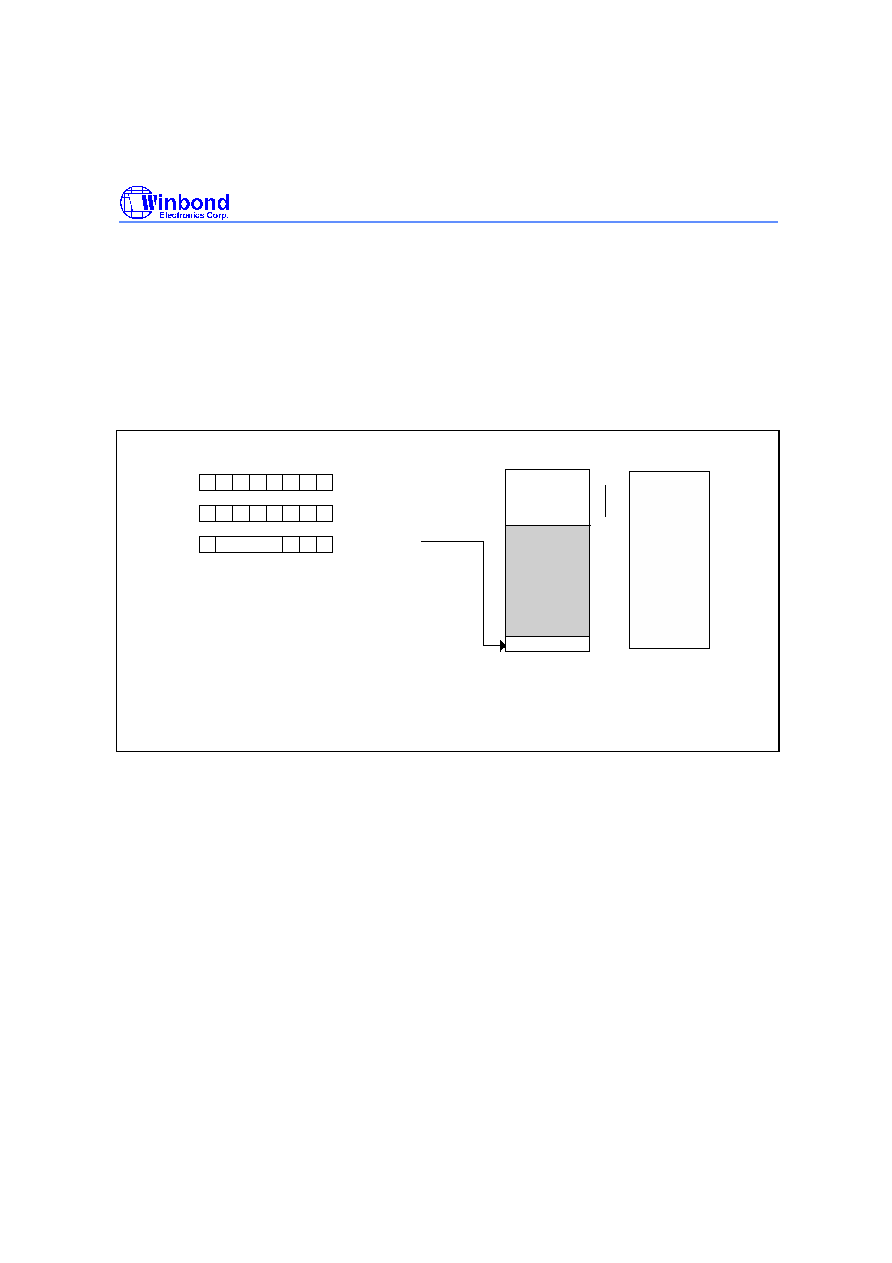
Preliminary W78LE516
Publication Release Date: June 2000
- 17 - Revision A1
SECURITY
During the on-chip MTP-ROM programming mode, the MTP-ROM can be programmed and verified
repeatedly. Until the code inside the MTP-ROM is confirmed OK, the code can be protected. The
protection of MTP-ROM and those operations on it are described below.
The W78LE516 has several Special Setting Registers, including the Security Register and
Company/Device ID Registers, which can not be accessed in programming mode. Those bits of the
Security Registers can not be changed once they have been programmed from high to low. They can
only be reset through erase-all operation. The contents of the Company ID and Device ID registers
have been set in factory. The Security Register is located at the 0FFFFH of the LDROM space.
B0
B1
B0: Lock bit, logic 0: active
B1: MOVC inhibit,
logic 0: the MOVC instruction in external memory
cannot access the code in internal memory.
logic 1: no restriction.
Default 1 for all security bits.
Special Setting Registers
Company ID (#DAH)
D7 D6 D5 D4 D3 D2 D1 D0
1
1
0
1
1
0
1
0
Device ID (#62H)
0
1
1
1
0
0
0
Security Bits
0
4KB MTP ROM
Program Memory
Reserved
Security Register
FFFFh
0000h
0FFFh
Reserved
B2
B2: Encryption
logic 0: the encryption logic enable
logic 1: the encryption logic disable
Reserved bits must be kept in logic 1.
B7
B07: Osillator Control
logic 0: 1/2 gain
logic 1: Full gain
LDROM
Reserved
64KB MTP ROM
Program Memory
APROM
Lock bit
This bit is used to protect the customer's program code in the W78LE516. It may be set after the
programmer finishes the programming and verifies sequence. Once this bit is set to logic 0, both the
MTP ROM data and Special Setting Registers can? be accessed again.
MOVC Inhibit
This bit is used to restrict the accessible region of the MOVC instruction. It can prevent the MOVC
instruction in external program memory from reading the internal program code. When this bit is set
to logic 0, a MOVC instruction in external program memory space will be able to access code only in
the external memory, not in the internal memory. A MOVC instruction in internal program memory
space will always be able to access the ROM data in both internal and external memory. If this bit is
logic 1, there are no restrictions on the MOVC instruction.
Encryption
This bit is used to enable/disable the encryption logic for code protection. Once encryption feature is
enabled, the data presented on port 0 will be encoded via encryption logic. Only whole chip erase will
reset this bit.
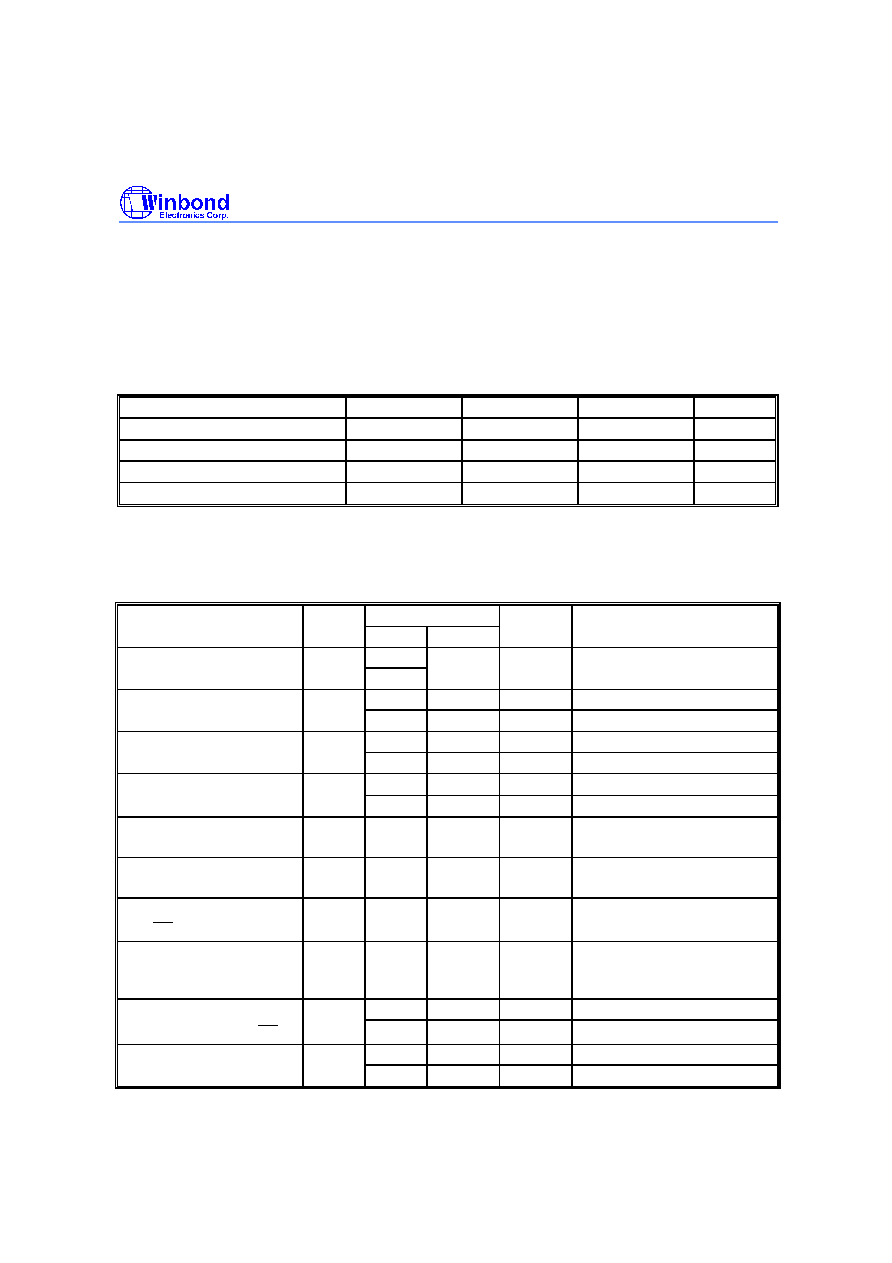
Preliminary W78LE516
- 18 -
Oscillator Control
W78LE516/E516 allow user to diminish the gain of on-chip oscillator amplifier by using programmer
to set the bit B7 of security register. Once B7 is set to 0, a half of gain will be decreased. Care must
be taken if user attempts to diminish the gain of oscillator amplifier, reducing a half of gain may
improperly affect the external crystal operation at high frequency. The value of C1 and C2 may need
some adjustment while running at lower gain.
ABSOLUTE MAXIMUM RATINGS
PARAMETER
SYMBOL
MIN.
MAX.
UNIT
DC Power Supply
V
DD
-
V
SS
-0.3
+6.0
V
Input Voltage
V
IN
V
SS
-0.3
V
DD
+0.3
V
Operating Temperature
T
A
0
60
∞
C
Storage Temperature
T
ST
-55
+150
∞
C
Note: Exposure to conditions beyond those listed under Absolute Maximum Ratings may adversely affect the life and reliability
of the device.
DC CHARACTERISTICS
V
SS
= 0V, T
A
= 25
∞
C, unless otherwise specified.
PARAMETER
SYM. SPECIFICATION
UNIT
TEST CONDITIONS
MIN.
MAX.
Operating Voltage
V
DD
2.4
5.5
V
Without I.S.P.
3.3
5.5
V
With I.S.P.
Operating Current
I
DD
-
20
mA
No load V
DD
= 5.5V
-
3
mA
No load V
DD
= 2.4V
Idle Current
I
IDLE
-
6
mA
V
DD
= 5.5V, Fosc = 20 MHz
-
1.5
mA
V
DD
= 2.4V, Fosc = 12 MHz
Power Down Current
I
PWDN
-
50
µ
A
V
DD
= 5.5V, Fosc = 20 MHz
-
20
µ
A
V
DD
= 2.4V, Fosc = 12 MHz
Input Current
P1, P2, P3, P4
I
IN1
-50
+10
µ
A
V
DD
= 5.5V
V
IN
= 0V or V
DD
Input Current
RST
I
IN2
-10
+300
µ
A
V
DD
= 5.5V
0 < V
IN
< V
DD
Input Leakage Current
P0, EA
I
LK
-10
+10
µ
A
V
DD
= 5.5V
0V < V
IN
< V
DD
Logic 1 to 0 Transition
Current
P1, P2, P3, P4
I
TL
[*4]
-500
-
µ
A
V
DD
= 5.5V
V
IN
= 2.0V
Input Low Voltage
V
IL1
0
0.8
V
V
DD
= 4.5V
P0, P1, P2, P3, P4, EA
0
0.5
V
V
DD
= 2.4V
Input Low Voltage
V
IL2
0
0.8
V
V
DD
= 4.5V
RST[*1]
0
0.3
V
V
DD
= 2.4V

Preliminary W78LE516
Publication Release Date: June 2000
- 19 - Revision A1
DC Characteristics, continued
PARAMETER
SYM.
SPECIFICATION
UNIT
TEST CONDITIONS
MIN.
MAX.
Input Low Voltage
V
IL3
0
0.8
V
V
DD
= 4.5V
XTAL1 [*3]
0
0.4
V
V
DD
= 2.4V
Input High Voltage
V
IH1
2.4
V
DD
+0.2
V
V
DD
= 5.5V
P0, P1, P2, P3, P4, EA
1.4
V
DD
+0.2
V
V
DD
= 2.4V
Input High Voltage
V
IH2
3.5
V
DD
+0.2
V
V
DD
= 5.5V
RST[*1]
1.7
V
DD
+0.2
V
V
DD
= 2.4V
Input High Voltage
V
IH3
3.5
V
DD
+0.2
V
V
DD
= 5.5V
XTAL1 [*3]
2.4
V
DD
+0.2
V
V
DD
= 2.4V
Output Low Voltage
V
OL1
-
0.45
V
V
DD
= 4.5V, I
OL
= +2 mA
P1, P2, P3, P4
-
0.25
V
V
DD
= 2.4V, I
OL
= +1 mA
Output Low Voltage
V
OL2
-
0.45
V
V
DD
= 4.5V, I
OL
= +4 mA
P0, ALE, PSEN [*2]
-
0.25
V
V
DD
= 2.4V, I
OL
= +2 mA
Sink Current
I
SK1
4
12
mA
V
DD
= 4.5V, Vin = 0.45V
P1, P2, P3, P4
1.8
5.4
mA
V
DD
= 2.4V, Vin = 0.45V
Sink Current
I
SK2
8
16
mA
V
DD
= 4.5V, Vin = 0.45V
P0, ALE, PSEN
4.5
9
mA
V
DD
= 2.4V, Vin = 0.4V
Output High Voltage
V
OH1
2.4
-
V
V
DD
= 4.5V, I
OH
= -100
µ
A
P1, P2, P3, P4
1.4
-
V
V
DD
= 2.4V, I
OH
= -8
µ
A
Output High Voltage
V
OH2
2.4
-
V
V
DD
= 4.5V, I
OH
= -400
µ
A
P0, ALE, PSEN [*2]
1.4
-
V
V
DD
= 2.4V, I
OH
= -200
µ
A
Source Current
I
SR1
-100
-250
µ
A
V
DD
= 4.5V, Vin = 2.4V
P1, P2, P3, P4
-20
-50
µ
A
V
DD
= 2.4V, Vin = 1.4V
Source Current
I
SR2
-8
-14
mA
V
DD
= 4.5V, Vin = 2.4V
P0, ALE, PSEN
-1.9
-3.8
mA
V
DD
= 2.4V, Vin = 1.4V
Notes:
*1. RST pin is a Schmitt trigger input.
*2. P0, ALE and PSEN are tested in the external access mode.
*3. XTAL1 is a CMOS input.
*4. Pins of P1, P2, P3, P4 can source a transition current when they are being externally driven from 1 to 0.
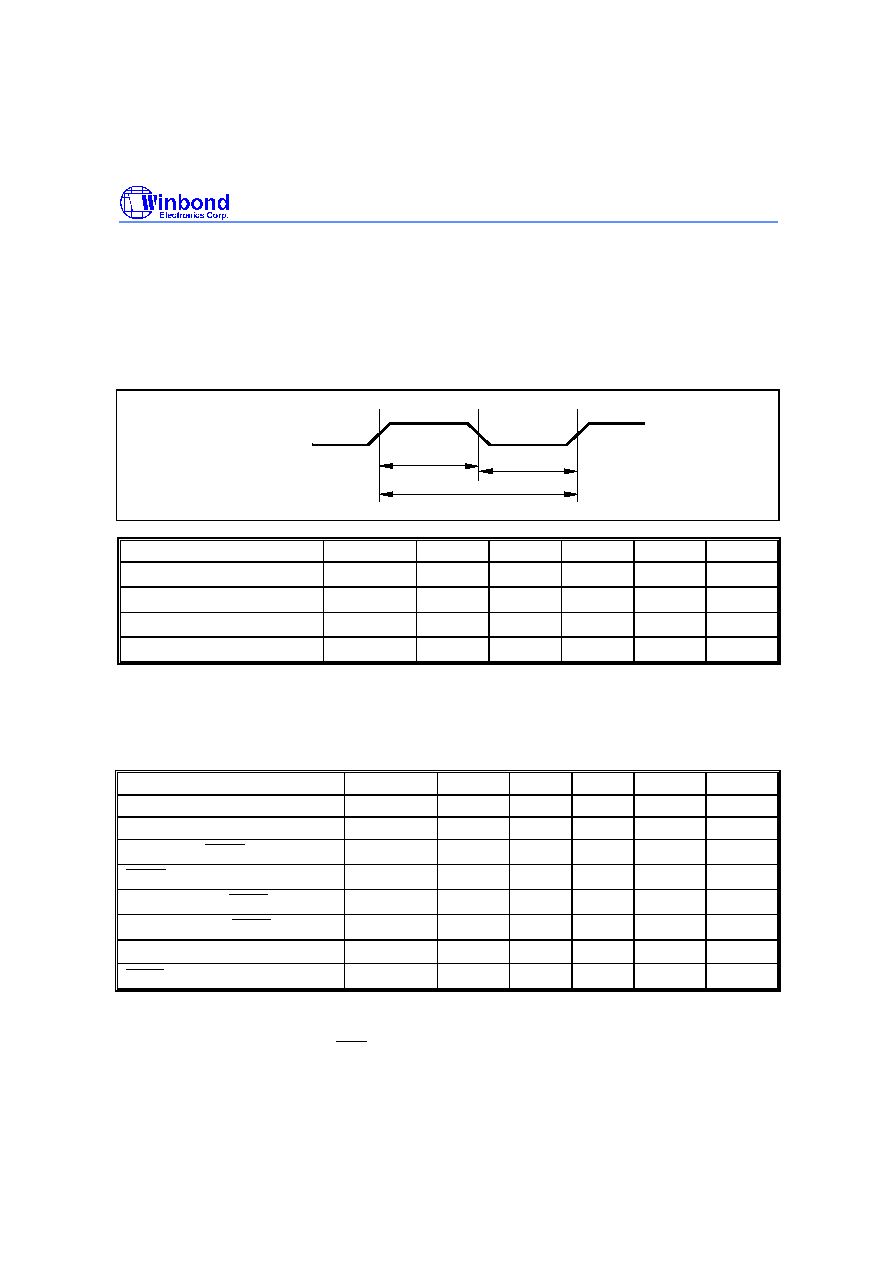
Preliminary W78LE516
- 20 -
AC CHARACTERISTICS
The AC specifications are a function of the particular process used to manufacture the part, the
ratings of the I/O buffers, the capacitive load, and the internal routing capacitance. Most of the
specifications can be expressed in terms of multiple input clock periods (T
CP
), and actual parts will
usually experience less than a
±
20 nS variation. The numbers below represent the performance
expected from a 0.6 micron CMOS process when using 2 and 4 mA output buffers.
Clock Input Waveform
T
T
XTAL1
F
CH
CL
OP,
T
CP
PARAMETER
SYMBOL
MIN.
TYP.
MAX.
UNIT
NOTES
Operating Speed
F
OP
0
-
24
MHz
1
Clock Period
T
CP
25
-
-
nS
2
Clock High
T
CH
10
-
-
nS
3
Clock Low
T
CL
10
-
-
nS
3
Notes:
1. The clock may be stopped indefinitely in either state.
2. The T
CP
specification is used as a reference in other specifications.
3. There are no duty cycle requirements on the XTAL1 input.
Program Fetch Cycle
PARAMETER
SYMBOL
MIN.
TYP.
MAX.
UNIT
NOTES
Address Valid to ALE Low
T
AAS
1 T
CP
-
-
-
nS
4
Address Hold from ALE Low
T
AAH
1 T
CP
-
-
-
nS
1, 4
ALE Low to
PSEN
Low
T
APL
1 T
CP
-
-
-
nS
4
PSEN
Low to Data Valid
T
PDA
-
-
2 T
CP
nS
2
Data Hold after PSEN High
T
PDH
0
-
1 T
CP
nS
3
Data Float after PSEN High
T
PDZ
0
-
1 T
CP
nS
ALE Pulse Width
T
ALW
2 T
CP
-
2 T
CP
-
nS
4
PSEN Pulse Width
T
PSW
3 T
CP
-
3 T
CP
-
nS
4
Notes:
1. P0.0
-
P0.7, P2.0
-
P2.7 remain stable throughout entire memory cycle.
2. Memory access time is 3 T
CP
.
3. Data have been latched internally prior to PSEN going high.
4. "
" (due to buffer driving delay and wire loading) is 20 nS.
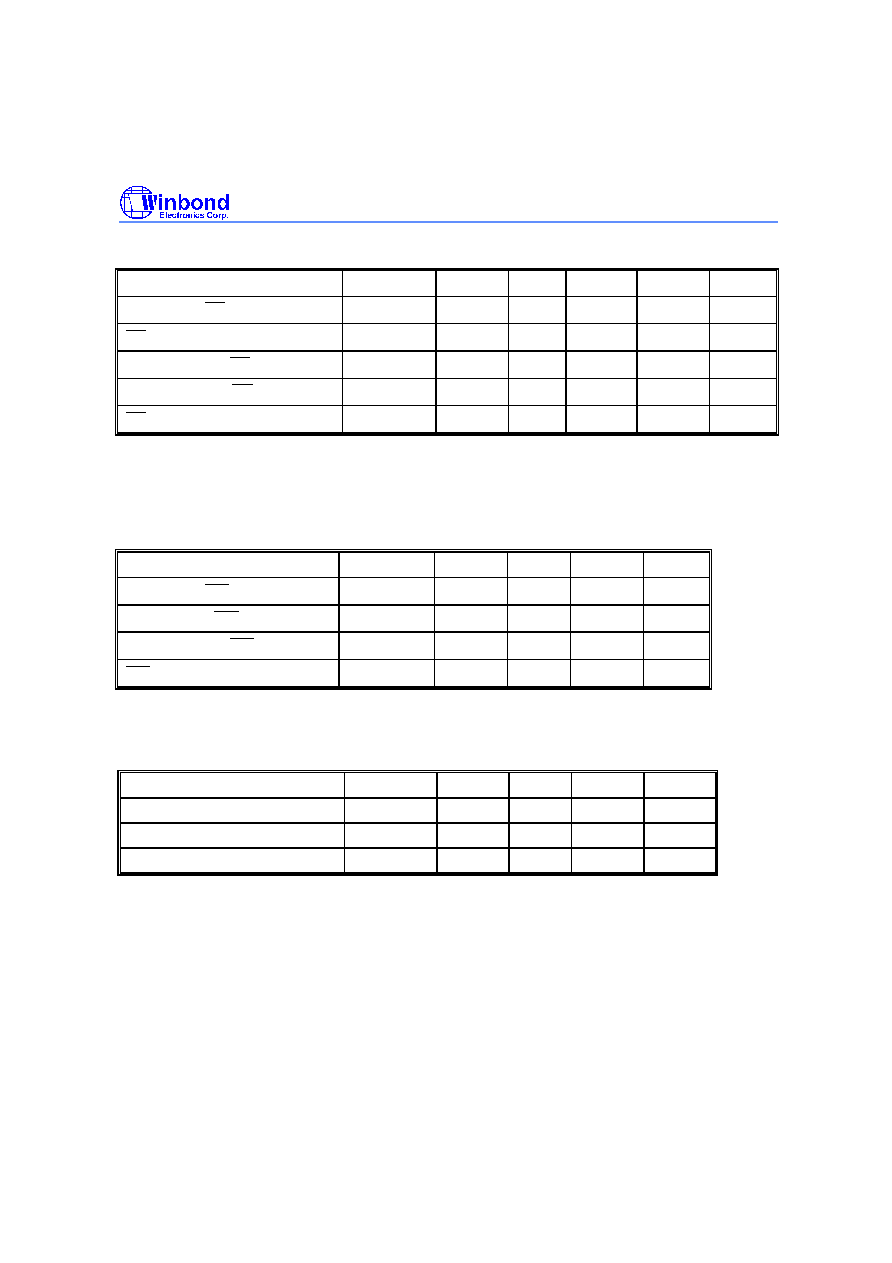
Preliminary W78LE516
Publication Release Date: June 2000
- 21 - Revision A1
Data Read Cycle
PARAMETER
SYMBOL
MIN.
TYP.
MAX.
UNIT
NOTES
ALE Low to RD Low
T
DAR
3 T
CP
-
-
3 T
CP+
nS
1, 2
RD Low to Data Valid
T
DDA
-
-
4 T
CP
nS
1
Data Hold from RD High
T
DDH
0
-
2 T
CP
nS
Data Float from RD High
T
DDZ
0
-
2 T
CP
nS
RD Pulse Width
T
DRD
6 T
CP
-
6 T
CP
-
nS
2
Notes:
1. Data memory access time is 8 T
CP
.
2. "
" (due to buffer driving delay and wire loading) is 20 nS.
Data Write Cycle
PARAMETER
SYMBOL
MIN.
TYP.
MAX.
UNIT
ALE Low to WR Low
T
DAW
3 T
CP
-
-
3 T
CP
+
nS
Data Valid to WR Low
T
DAD
1 T
CP
-
-
-
nS
Data Hold from WR High
T
DWD
1 T
CP
-
-
-
nS
WR Pulse Width
T
DWR
6 T
CP
-
6 T
CP
-
nS
Note: "
" (due to buffer driving delay and wire loading) is 20 nS.
Port Access Cycle
PARAMETER
SYMBOL
MIN.
TYP.
MAX.
UNIT
Port Input Setup to ALE Low
T
PDS
1 TCP
-
-
nS
Port Input Hold from ALE Low
T
PDH
0
-
-
nS
Port Output to ALE
T
PDA
1 TCP
-
-
nS
Note: Ports are read during S5P2, and output data becomes available at the end of S6P2. The timing data are referenced to
ALE, since it provides a convenient reference.
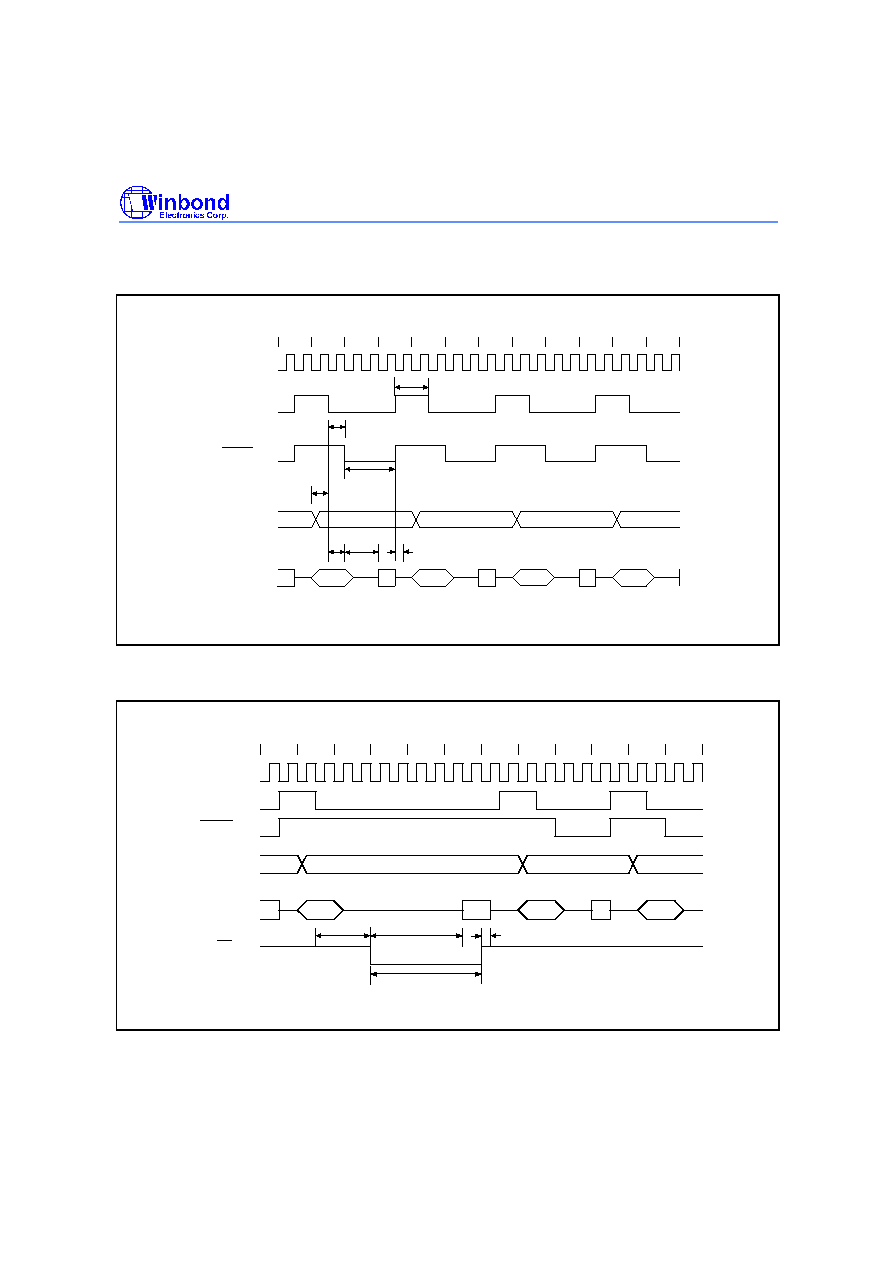
Preliminary W78LE516
- 22 -
TIMING WAVEFORMS
Program Fetch Cycle
S1
XTAL1
S2
S3
S4
S5
S6
S1
S2
S3
S4
S5
S6
ALE
PORT 2
A0-A7
A0-A7
Data
A0-A7
Code
T
A0-A7
Data
Code
PORT 0
PSEN
PDH,
T
PDZ
T
PDA
T
AAH
T
AAS
T
PSW
T
APL
T
ALW
Data Read Cycle
S2
S3
S5
S6
S1
S2
S3
S4
S5
S6
S1
S4
XTAL1
ALE
PSEN
DATA
A8-A15
PORT 2
PORT 0
A0-A7
RD
T
DDH,
T
DDZ
T
DDA
T
DRD
T
DAR
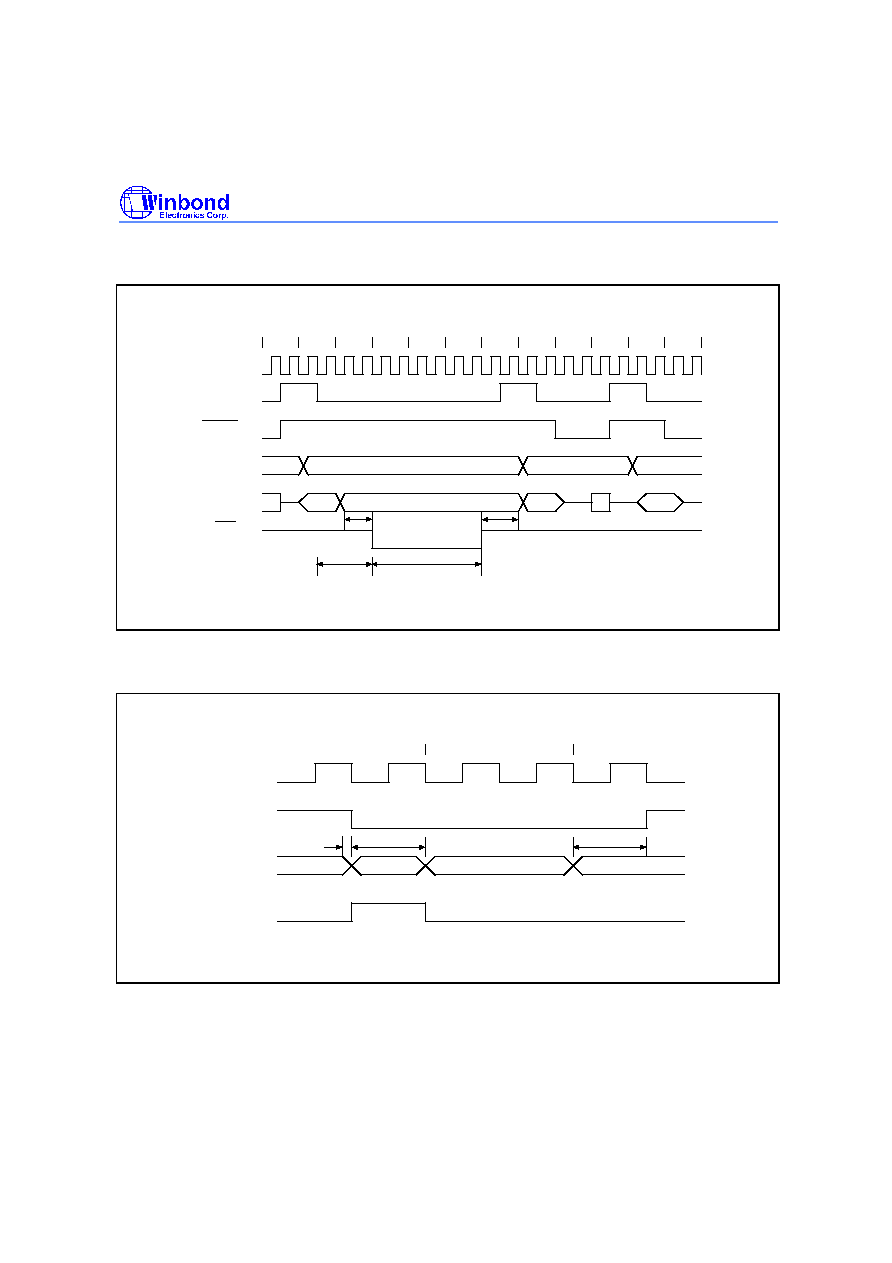
Preliminary W78LE516
Publication Release Date: June 2000
- 23 - Revision A1
Timing Waveforms, continued
Data Write Cycle
S2
S3
S5
S6
S1
S2
S3
S4
S1
S5
S6
S4
XTAL1
ALE
PSEN
A8-A15
DATA OUT
PORT 2
PORT 0
A0-A7
WR
T
T
DAW
DAD
T
DWR
T
DWD
Port Access Cycle
XTAL1
ALE
S5
S6
S1
DATA OUT
T
T
PORT
INPUT
T
SAMPLE
PDA
PDH
PDS

Preliminary W78LE516
- 24 -
TYPICAL APPLICATION CIRCUIT
Expanded External Program Memory and Crystal
AD0
A0
A0
A0
10
A1
9
A2
8
A3
7
A4
6
A5
5
A6
4
A7
3
A8
25
A9
24
A10
21
A11
23
A12
2
A13
26
A14
27
A15
1
CE
20
OE
22
O0
11
O1
12
O2
13
O3
15
O4
16
O5
17
O6
18
O7
19
27512
AD0
D0
3
Q0
2
D1
4
Q1
5
D2
7
Q2
6
D3
8
Q3
9
D4
13
Q4
12
D5
14
Q5
15
D6
17
Q6
16
D7
18
Q7
19
OC
1
G
11
74LS373
AD0
EA
31
XTAL1
19
XTAL2
18
RST
9
INT0
12
INT1
13
T0
14
T1
15
P1.0
1
P1.1
2
P1.2
3
P1.3
4
P1.4
5
P1.5
6
P1.6
7
P1.7
8
39
38
37
36
35
34
33
32
21
22
23
24
25
26
27
28
17
WR
P0.0
P0.1
P0.2
P0.3
P0.4
P0.5
P0.6
P0.7
P2.0
P2.1
P2.2
P2.3
P2.4
P2.5
P2.6
P2.7
RD
16
PSEN
29
ALE
30
TXD
11
RXD
10
W78LE516
10 u
8.2 K
V
CRYSTAL
C1
C2
R
AD1
AD2
AD3
AD4
AD5
AD6
AD7
A8
AD1
AD2
AD3
AD4
AD5
AD6
AD7
GND
A1
A2
A3
A4
A5
A6
A7
A1
A2
A3
A4
A5
A6
A7
A8
A9
AD1
AD2
AD3
AD4
AD5
AD6
AD7
A10
A11
A12
A13
A14
A15
GND
A9
A10
A11
A12
A13
A14
A15
DD
Figure A
CRYSTAL
C1
C2
R
6 MHz
47P
47P
-
16 MHz
30P
30P
-
24 MHz
15P
10P
-
Above table shows the reference values for crystal applications.
Notes:
1. C1, C2, R components refer to Figure A
2. Crystal layout must get close to XTAL1 and XTAL2 pins on user's application board.

Preliminary W78LE516
Publication Release Date: June 2000
- 25 - Revision A1
Tipical Application Circuit, continued
Expanded External Data Memory and Oscillator
10 u
8.2 K
V
OSCILLATOR
EA
31
XTAL1
19
XTAL2
18
RST
9
INT0
12
INT1
13
T0
14
T1
15
P1.0
1
P1.1
2
P1.2
3
P1.3
4
P1.4
5
P1.5
6
P1.6
7
P1.7
8
P0.0
39
P0.1
38
P0.2
37
P0.3
36
P0.4
35
P0.5
34
P0.6
33
P0.7
32
P2.0
21
P2.1
22
P2.2
23
P2.3
24
P2.4
25
P2.5
26
P2.6
27
P2.7
28
RD
17
WR
16
PSEN
29
ALE
30
TXD
11
RXD
10
W78LE516
AD0
AD1
AD2
AD3
AD4
AD5
AD6
AD7
AD0
AD1
AD2
AD3
AD4
AD5
AD6
AD7
A0
A1
A2
A3
A4
A5
A6
A7
D0
3
Q0
2
D1
4
Q1
5
D2
7
Q2
6
D3
8
Q3
9
D4
13
Q4
12
D5
14
Q5
15
D6
17
Q6
16
D7
18
Q7
19
OC
1
G
11
74LS373
A0
A1
A2
A3
A4
A5
A6
A7
10
9
8
7
6
5
4
3
A0
A1
A2
A3
A4
A5
A6
A7
AD0
AD1
AD2
AD3
AD4
AD5
AD6
AD7
11
12
13
15
16
17
18
19
D0
D1
D2
D3
D4
D5
D6
D7
A8
A9
A10
A11
A12
A13
A14
25
24
21
23
26
1
20
2
A8
A9
A10
A11
A12
A13
A14
CE
GND
A8
A9
A10
A11
A12
A13
A14
GND
22
27
OE
WR
20256
DD
V
DD
Figure B
PACKAGE DIMENSIONS
40-pin DIP
Seating Plane
1. Dimension D Max. & S include mold flash or
tie bar burrs.
2. Dimension E1 does not include interlead flash.
3. Dimension D & E1 include mold mismatch and
are determined at the mold parting line.
6. General appearance spec. should be based on
final visual inspection spec.
.
1.372
1.219
0.054
0.048
Notes:
Symbol
Min. Nom.
Max.
Max.
Nom.
Min.
Dimension in inch
Dimension in mm
0.050
1.27
0.210
5.334
0.010
0.150
0.016
0.155
0.018
0.160
0.022
3.81
0.406
0.254
3.937
0.457
4.064
0.559
0.008
0.120
0.670
0.010
0.130
0.014
0.140
0.203
3.048
0.254
3.302
0.356
3.556
0.540
0.550
0.545
13.72
13.97
13.84
17.01
15.24
14.986
15.494
0.600
0.590
0.610
2.286
2.54
2.794
0.090
0.100
0.110
A
B
c
D
e
A
L
S
A
A
1
2
E
B
1
1
e
E
1
a
2.055
2.070
52.20
52.58
0
15
0.090
2.286
0.650
0.630
16.00
16.51
protrusion/intrusion.
4. Dimension B1 does not include dambar
5. Controlling dimension: Inches.
15
0
e
A
A
a
c
E
Base Plane
1
A
1
e
L
A
S
1
E
D
1
B
B
40
21
20
1
2
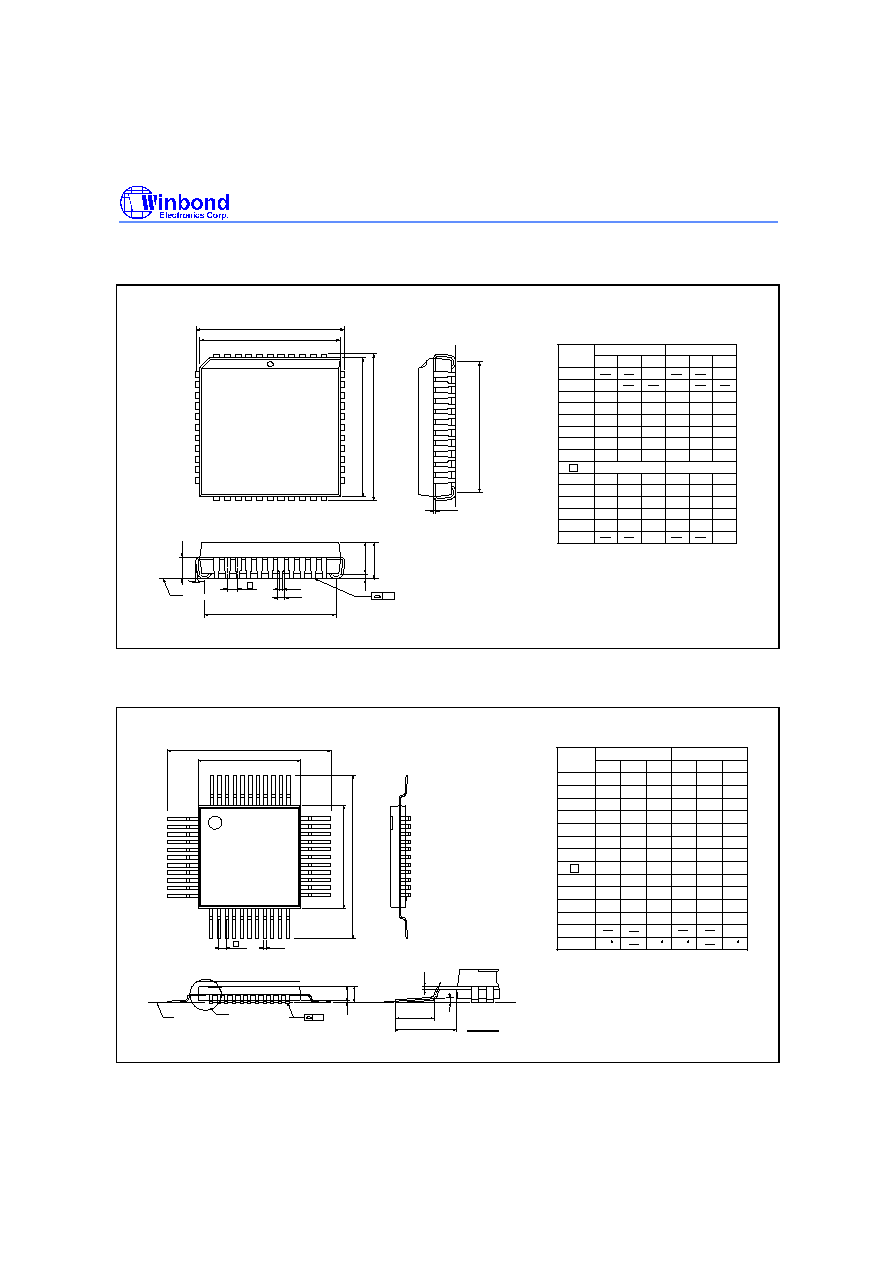
Preliminary W78LE516
- 26 -
Package Dimensions, continued
44-pin PLCC
44
40
39
29
28
18
17
7
6
1
L
c
1
b
2
A
H
D
D
e
b
E
H
E
y
A
A
1
Seating Plane
D
G
G
E
Symbol
Min. Nom.
Max.
Max.
Nom.
Min.
Dimension in inch
Dimension in mm
A
b
c
D
e
H
E
L
y
A
A
1
2
E
b
1
H
D
G
G
D
E
Notes:
on final visual inspection spec.
4. General appearance spec. should be based
3. Controlling dimension: Inches
protrusion/intrusion.
2. Dimension b1 does not include dambar
flash.
1. Dimension D & E do not include interlead
0.020
0.145
0.026
0.016
0.008
0.648
0.590
0.680
0.090
0.150
0.028
0.018
0.010
0.653
0.610
0.690
0.100
0.050
BSC
0.185
0.155
0.032
0.022
0.014
0.658
0.630
0.700
0.110
0.004
0.508
3.683
0.66
0.406
0.203
16.46
14.99
17.27
2.296
3.81
0.711
0.457
0.254
16.59
15.49
17.53
2.54
1.27
4.699
3.937
0.813
0.559
0.356
16.71
16.00
17.78
2.794
0.10
BSC
16.71
16.59
16.46
0.658
0.653
0.648
16.00
15.49
14.99
0.630
0.610
0.590
17.78
17.53
17.27
0.700
0.690
0.680
44-pin PQFP
Seating Plane
11
22
12
See Detail F
e
b
A
y
1
A
A
L
L
1
c
E
E
H
1
D
44
H
D
34
33
Detail F
1. Dimension D & E do not include interlead
flash.
2. Dimension b does not include dambar
protrusion/intrusion.
3. Controlling dimension: Millimeter
4. General appearance spec. should be based
on final visual inspection spec.
0.254
0.101
0.010
0.004
Notes:
Symbol
Min.
Nom.
Max.
Max.
Nom.
Min.
Dimension in inch
Dimension in mm
A
b
c
D
e
H
D
H
E
L
y
A
A
L
1
1
2
E
0.006
0.152
---
0.002
0.075
0.01
0.081
0.014
0.087
0.018
1.90
0.25
0.05
2.05
0.35
2.20
0.45
0.390
0.025
0.063
0.003
0
7
0.394
0.031
0.398
0.037
9.9
0.80
0.65
1.6
10.00
0.8
10.1
0.95
0.398
0.394
0.390
0.530
0.520
0.510
13.45
13.2
12.95
10.1
10.00
9.9
7
0
0.08
0.031
0.01
0.02
0.25
0.5
---
---
---
---
---
2
0.025
0.036
0.635
0.952
0.530
0.520
0.510
13.45
13.2
12.95
0.051
0.075
1.295
1.905

Preliminary W78LE516
Publication Release Date: June 2000
- 27 - Revision A1
Application Note: In-system Programming Software Examples
This application note illustrates the in-system programmability of the Winbond W78LE516 MTP-ROM
microcontroller. In this example, microcontroller will boot from 64 KB APROM bank and waiting for a
key to enter in-system programming mode for re-programming the contents of 64 KB APROM. While
entering in-system programming mode, microcontroller executes the loader program in 4KB LDROM
bank. The loader program erases the 64 KB APROM then reads the new code data from external
SRAM buffer (or through other interfaces) to update the 64KB APROM.
EXAMPLE 1:
;*******************************************************************************************************************
;* Example of 64K APROM program: Program will scan the P1.0. if P1.0 = 0, enters in-system
;* programming mode for updating the content of APROM code else executes the current ROM code.
;* XTAL = 16 MHz
;*******************************************************************************************************************
.chip 8052
.RAMCHK OFF
.symbols
CHPCON EQU BFH
CHPENR EQU F6H
SFRAL EQU C4H
SFRAH EQU C5H
SFRFD EQU C6H
SFRCN EQU C7H
ORG 0H
LJMP 100H ; JUMP TO MAIN PROGRAM
;************************************************************************
;* TIMER0 SERVICE VECTOR ORG = 000BH
;************************************************************************
ORG 00BH
CLR TR0 ; TR0 = 0, STOP TIMER0
MOV TL0,R6
MOV TH0,R7
RETI
;************************************************************************
;* 64K APROM MAIN PROGRAM
;************************************************************************
ORG 100H
MAIN_64K:
MOV A,P1 ; SCAN P1.0
ANL A,#01H
CJNE A,#01H,PROGRAM_64K ; IF P1.0 = 0, ENTER IN-SYSTEM PROGRAMMING MODE
JMP NORMAL_MODE
PROGRAM_64K:
MOV CHPENR,#87H ; CHPENR = 87H, CHPCON REGISTER WRTE ENABLE
MOV CHPENR,#59H ; CHPENR = 59H, CHPCON REGISTER WRITE ENABLE
MOV CHPCON,#03H ; CHPCON = 03H, ENTER IN-SYSTEM PROGRAMMING MODE
MOV TCON,#00H ; TR = 0 TIMER0 STOP
MOV IP,#00H ; IP = 00H

Preliminary W78LE516
- 28 -
MOV IE,#82H ; TIMER0 INTERRUPT ENABLE FOR WAKE-UP FROM IDLE MODE
MOV R6,#FEH ; TL0 = FEH
MOV R7,#FFH ; TH0 = FFH
MOV TL0,R6
MOV TH0,R7
MOV TMOD,#01H ; TMOD = 01H, SET TIMER0 A 16-BIT TIMER
MOV TCON,#10H ; TCON = 10H, TR0 = 1,GO
MOV PCON,#01H ; ENTER IDLE MODE FOR LAUNCHING THE IN-SYSTEM
; PROGRAMMING
;********************************************************************************
;* Normal mode 64KB APROM program: depending user's application
;********************************************************************************
NORMAL_MODE:
. ; User's application program
.
.
.
EXAMPLE 2:
;*****************************************************************************************************************************
;* Example of 4 KB LDROM program: This loader program will erase the 64KB APROM first, then reads the new
;* code from external SRAM and program them into 64 KB APROM bank. XTAL = 16 MHz
;*****************************************************************************************************************************
.chip 8052
.RAMCHK OFF
.symbols
CHPCON EQU BFH
CHPENR EQU F6H
SFRAL EQU C4H
SFRAH EQU C5H
SFRFD EQU C6H
SFRCN EQU C7H
ORG 000H
LJMP 100H ; JUMP TO MAIN PROGRAM
;************************************************************************
;* 1. TIMER0 SERVICE VECTOR ORG = 0BH
;************************************************************************
ORG 000BH
CLR TR0 ; TR0 = 0, STOP TIMER0
MOV TL0,R6
MOV TH0,R7
RETI
;************************************************************************
;* 4KB LDROM MAIN PROGRAM
;************************************************************************
ORG 100H

Preliminary W78LE516
Publication Release Date: June 2000
- 29 - Revision A1
MAIN_4K:
MOV CHPENR,#87H ; CHPENR = 87H, CHPCON WRITE ENABLE.
MOV CHPENR,#59H ; CHPENR = 59H, CHPCON WRITE ENABLE.
MOV A,CHPCON
ANL A,#80H
CJNE A,#80H,UPDATE_64K ; CHECK F04KBOOT MODE ?
MOV CHPCON,#03H ; CHPCON = 03H, ENABLE IN-SYSTEM PROGRAMMING.
MOV CHPENR,#00H ; DISABLE CHPCON WRITE ATTRIBUTE
MOV TCON,#00H ; TCON = 00H, TR = 0 TIMER0 STOP
MOV TMOD,#01H ; TMOD = 01H, SET TIMER0 A 16BIT TIMER
MOV IP,#00H ; IP = 00H
MOV IE,#82H ; IE = 82H, TIMER0 INTERRUPT ENABLED
MOV R6,#FEH
MOV R7,#FFH
MOV TL0,R6
MOV TH0,R7
MOV TCON,#10H ; TCON = 10H, TR0 = 1, GO
MOV PCON,#01H ; ENTER IDLE MODE
UPDATE_64K:
MOV CHPENR,#00H ; DISABLE CHPCON WRITE-ATTRIBUTE
MOV TCON,#00H ; TCON = 00H , TR = 0 TIM0 STOP
MOV IP,#00H ; IP = 00H
MOV IE,#82H ; IE = 82H, TIMER0 INTERRUPT ENABLED
MOV TMOD,#01H ; TMOD = 01H, MODE1
MOV R6,#E0H ; SET WAKE-UP TIME FOR ERASE OPERATION, ABOUT 15 mS.
DEPENDING
; ON USER'S SYSTEM CLOCK RATE.
MOV R7,#B1H
MOV TL0,R6
MOV TH0,R7
ERASE_P_4K:
MOV SFRCN,#22H ; SFRCN(C7H) = 22H ERASE 64K
MOV TCON,#10H ; TCON = 10H, TR0 = 1,GO
MOV PCON,#01H ; ENTER IDLE MODE (FOR ERASE OPERATION)
;*********************************************************************
;* BLANK CHECK
;*********************************************************************
MOV SFRCN,#0H ; READ 64KB APROM MODE
MOV SFRAH,#0H ; START ADDRESS = 0H
MOV SFRAL,#0H
MOV R6,#FEH ; SET TIMER FOR READ OPERATION, ABOUT 1.5
µ
S.
MOV R7,#FFH
MOV TL0,R6
MOV TH0,R7
BLANK_CHECK_LOOP:
SETB TR0 ; ENABLE TIMER 0
MOV PCON,#01H ; ENTER IDLE MODE

Preliminary W78LE516
- 30 -
MOV A,SFRFD ; READ ONE BYTE
CJNE A,#FFH,BLANK_CHECK_ERROR
INC SFRAL ; NEXT ADDRESS
MOV A,SFRAL
JNZ BLANK_CHECK_LOOP
INC SFRAH
MOV A,SFRAH
CJNE A,#0H,BLANK_CHECK_LOOP ; END ADDRESS = FFFFH
JMP PROGRAM_64KROM
BLANK_CHECK_ERROR:
MOV P1,#F0H
MOV P3,#F0H
JMP $
;*******************************************************************************
;* RE-PROGRAMMING 64KB APROM BANK
;*******************************************************************************
PROGRAM_64KROM:
MOV DPTR,#0H ; THE ADDRESS OF NEW ROM CODE
MOV R2,#00H ; TARGET LOW BYTE ADDRESS
MOV R1,#00H ; TARGET HIGH BYTE ADDRESS
MOV DPTR,#0H ; EXTERNAL SRAM BUFFER ADDRESS
MOV SFRAH,R1 ; SFRAH, TARGET HIGH ADDRESS
MOV SFRCN,#21H ; SFRCN(C7H) = 21 (PROGRAM 64K)
MOV R6,#BEH ; SET TIMER FOR PROGRAMMING, ABOUT 50
µ
S.
MOV R7,#FFH
MOV TL0,R6
MOV TH0,R7
PROG_D_64K:
MOV SFRAL,R2 ; SFRAL(C4H) = LOW BYTE ADDRESS
MOVX A,@DPTR ; READ DATA FROM EXTERNAL SRAM BUFFER. BY ACCORDING USER?
; CIRCUIT, USER MUST MODIFY THIS INSTRUCTION TO FETCH CODE.
MOV SFRFD,A ; SFRFD(C6H) = DATA IN
MOV TCON,#10H ; TCON = 10H, TR0 = 1,GO
MOV PCON,#01H ; ENTER IDLE MODE (PRORGAMMING)
INC DPTR
INC R2
CJNE R2,#0H,PROG_D_64K
INC R1
MOV SFRAH,R1
CJNE R1,#0H,PROG_D_64K
;*****************************************************************************
; * VERIFY 64KB APROM BANK
;*****************************************************************************
MOV R4,#03H ; ERROR COUNTER
MOV R6,#FEH ; SET TIMER FOR READ VERIFY, ABOUT 1.5
µ
S.
MOV R7,#FFH
MOV TL0,R6
MOV TH0,R7
MOV DPTR,#0H ; The start address of sample code
MOV R2,#0H ; Target low byte address

Preliminary W78LE516
Publication Release Date: June 2000
- 31 - Revision A1
MOV R1,#0H ; Target high byte address
MOV SFRAH,R1 ; SFRAH, Target high address
MOV SFRCN,#00H ; SFRCN = 00 (Read Flash code)
READ_VERIFY_64K:
MOV SFRAL,R2 ; SFRAL(C4H) = LOW ADDRESS
MOV TCON,#10H ; TCON = 10H, TR0 = 1,GO
MOV PCON,#01H
INC R2
MOVX A,@DPTR
INC DPTR
CJNE A,SFRFD,ERROR_64K
CJNE R2,#0H,READ_VERIFY_64K
INC R1
MOV SFRAH,R1
CJNE R1,#0H,READ_VERIFY_64K
;******************************************************************************
;* PROGRAMMING COMPLETLY, SOFTWARE RESET CPU
;******************************************************************************
MOV CHPENR,#87H ; CHPENR = 87H
MOV CHPENR,#59H ; CHPENR = 59H
MOV CHPCON,#83H ; CHPCON = 83H, SOFTWARE RESET.
ERROR_64K:
DJNZ R4,UPDATE_64K ; IF ERROR OCCURS, REPEAT 3 TIMES.
. ; IN-SYSTEM PROGRAMMING FAIL, USER'S PROCESS TO DEAL WITH IT.
.
.
.
Headquarters
No. 4, Creation Rd. III,
Science -Based Industrial Park,
Hsinchu, Taiwan
TEL: 886 -3-5770066
FAX: 886 -3-5792766
http://www.winbond.com.tw/
Voice & Fax -on-demand: 886 -2-27197006
Taipei Office
11F, No. 115, Sec. 3, Min -Sheng East Rd.,
Taipei, Taiwan
TEL: 886 -2-27190505
FAX: 886 -2-27197502
Winbond Electronics (H.K.) Ltd.
Unit 9 -15, 22F, Millennium City,
No. 378 Kwun Tong Rd;
Kowloon, Hong Kong
TEL: 852 -27513100
FAX: 852 -27552064
Winbond Electronics North America Corp.
Winbond Memory Lab.
Winbond Microelectronics Corp.
Winbond Systems Lab.
2727 N. First Street, San Jose,
CA 95134, U.S.A.
TEL: 408 -9436666
FAX: 408 -5441798
Note: All data and specifications are subject to change withou t notice.
Headquarters
No. 4, Creation Rd. III,
Science -Based Industrial Park,
Hsinchu, Taiwan
TEL: 886 -3-5770066
FAX: 886 -3-5792766
http://www.winbond.com.tw/
Voice & Fax -on-demand: 886 -2-27197006
Taipei Office
11F, No. 115, Sec. 3, Min -Sheng East Rd.,
Taipei, Taiwan
TEL: 886 -2-27190505
FAX: 886 -2-27197502
Winbond Electronics (H.K.) Ltd.
Unit 9 -15, 22F, Millennium City,
No. 378 Kwun Tong Rd;
Kowloon, Hong Kong
TEL: 852 -27513100
FAX: 852 -27552064
Winbond Electronics North America Corp.
Winbond Memory Lab.
Winbond Microelectronics Corp.
Winbond Systems Lab.
2727 N. First Street, San Jose,
CA 95134, U.S.A.
TEL: 408 -9436666
FAX: 408 -5441798
Note: All data and specifications are subject to change withou t notice.






























